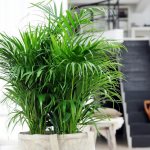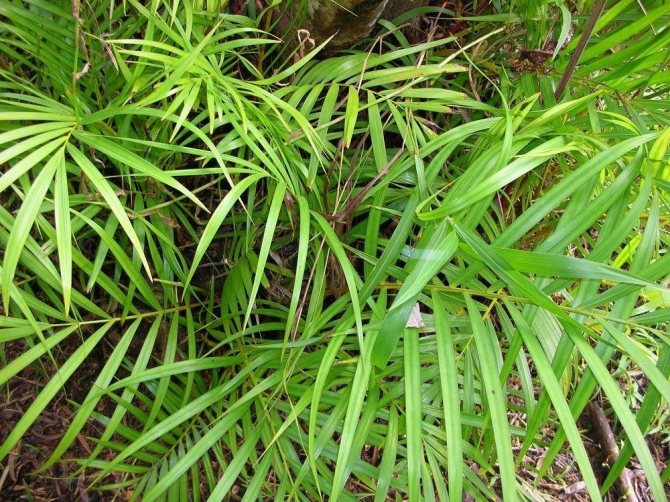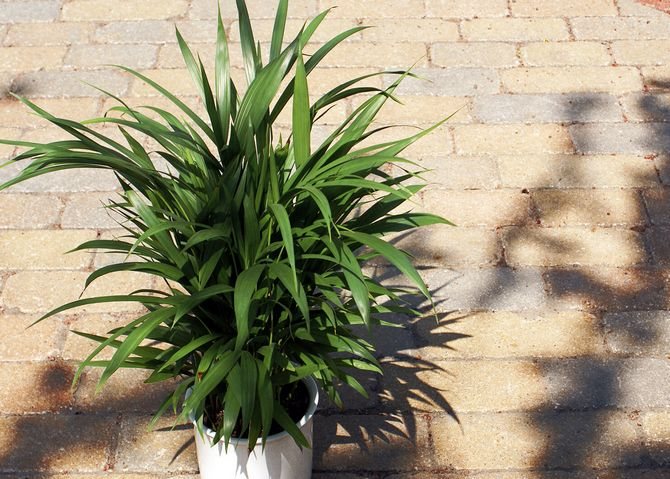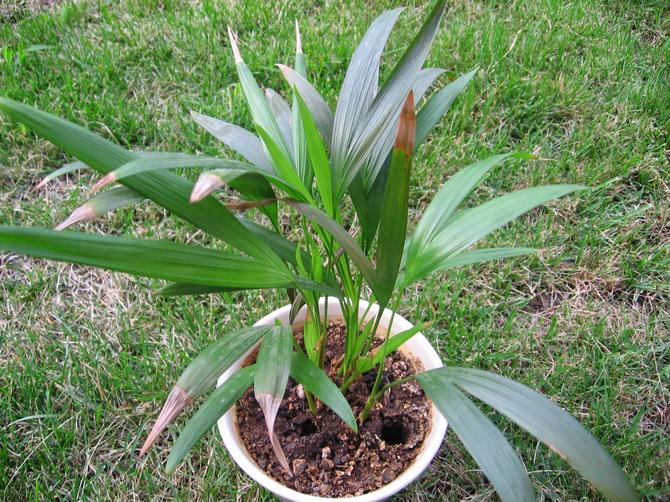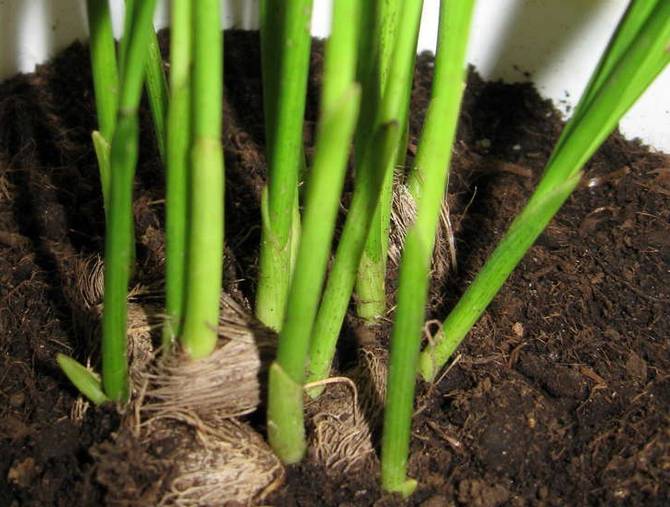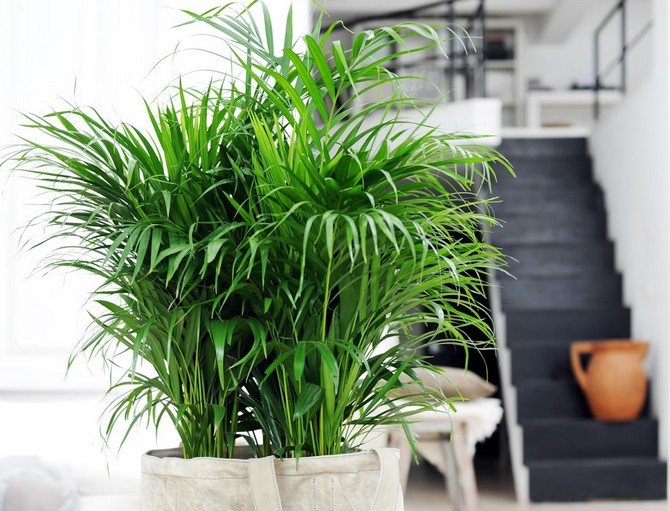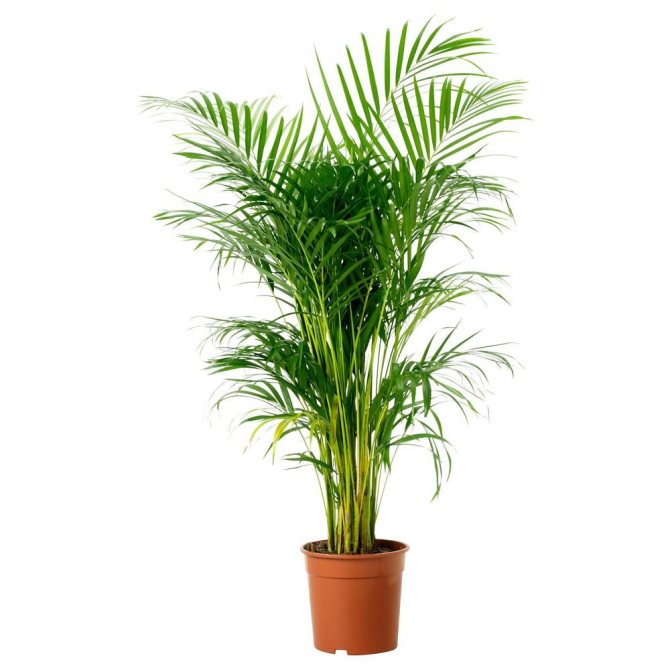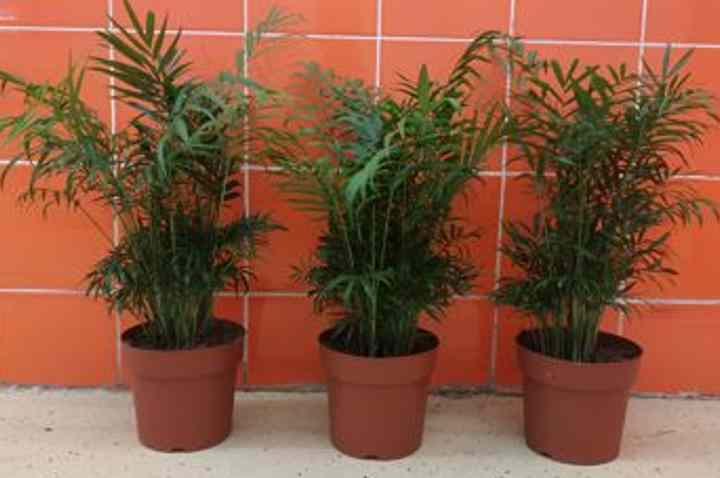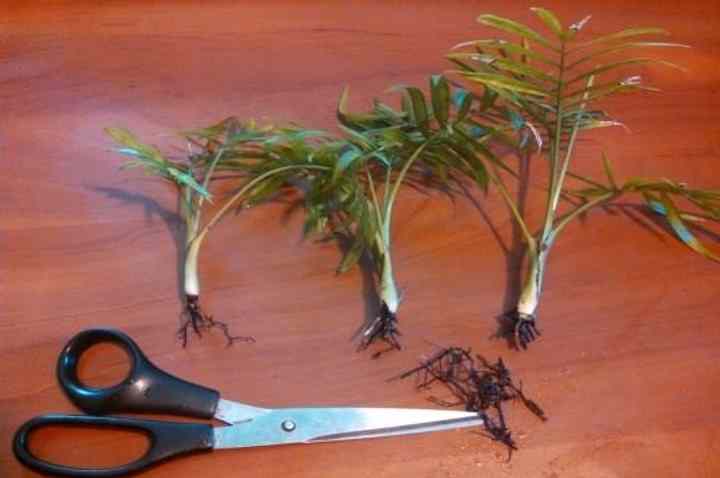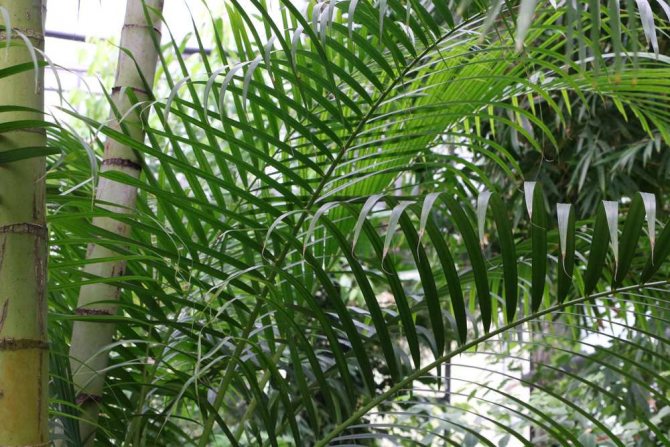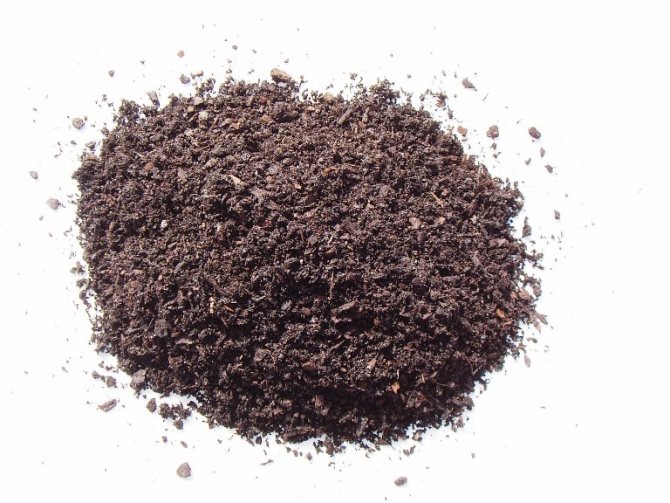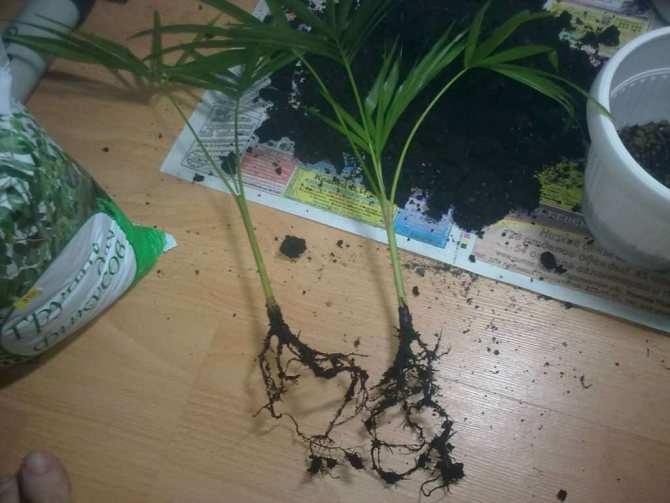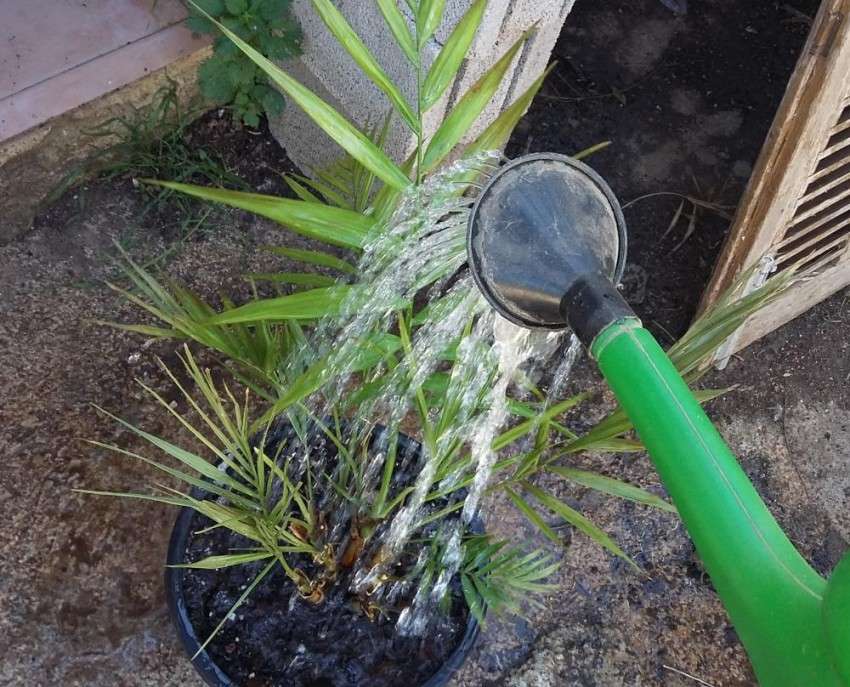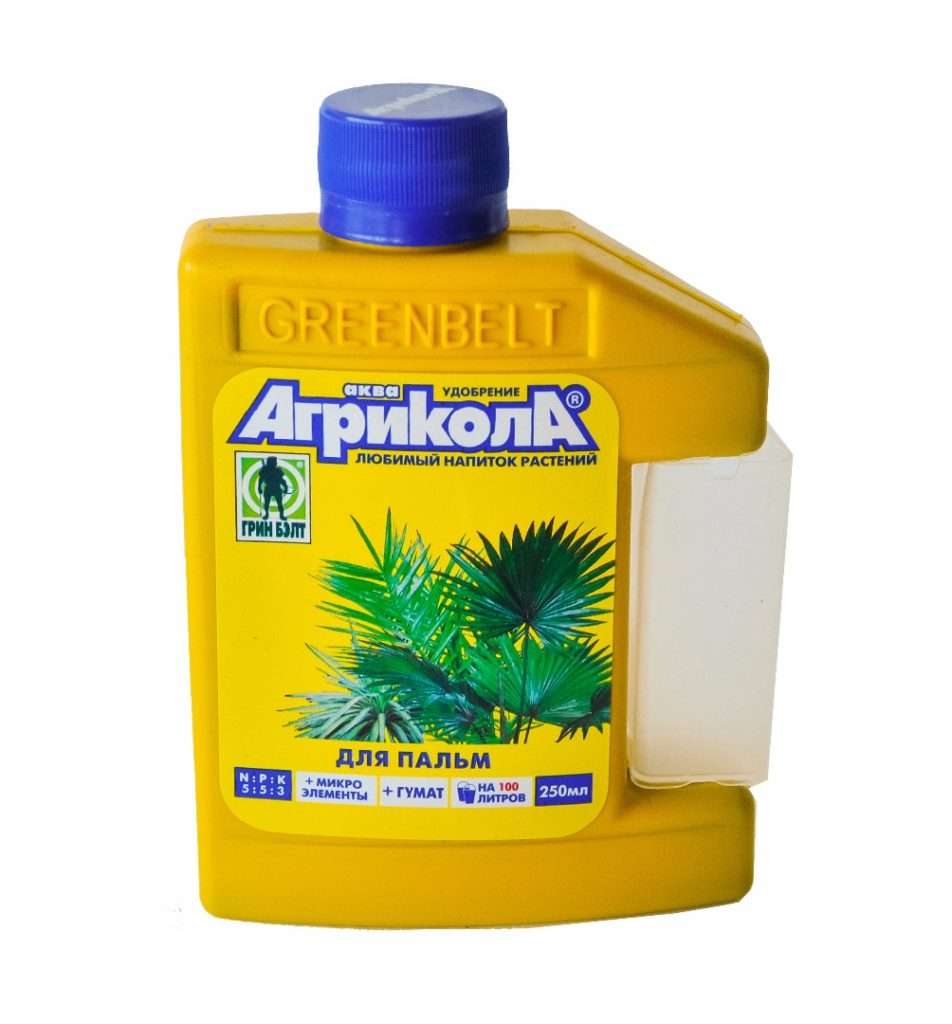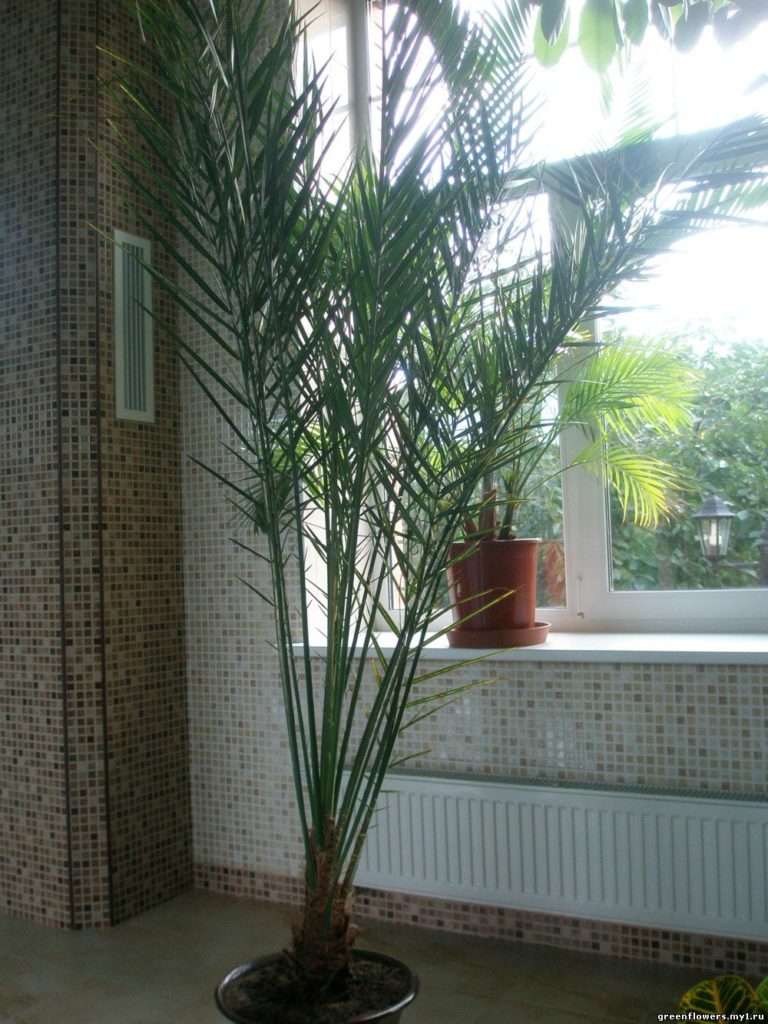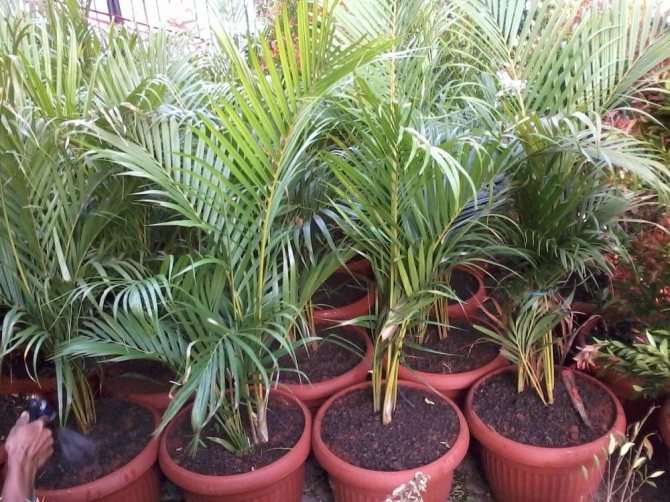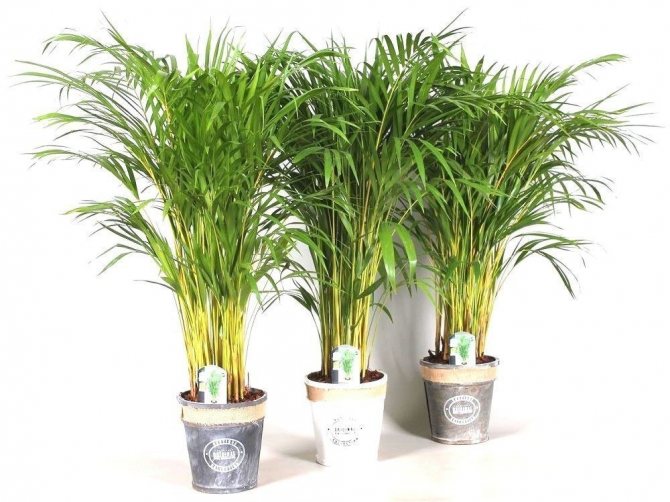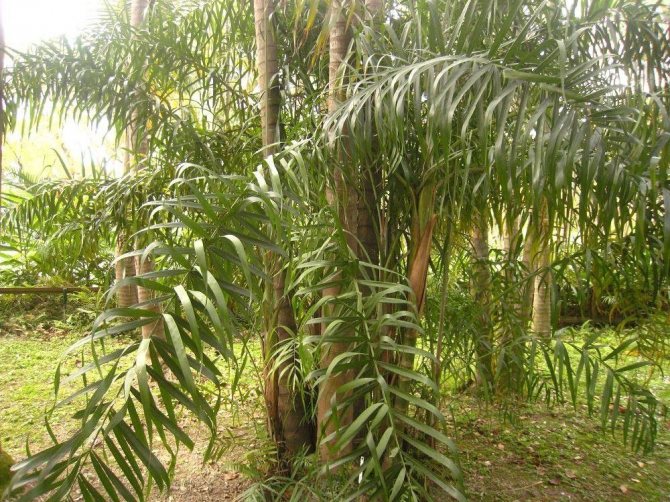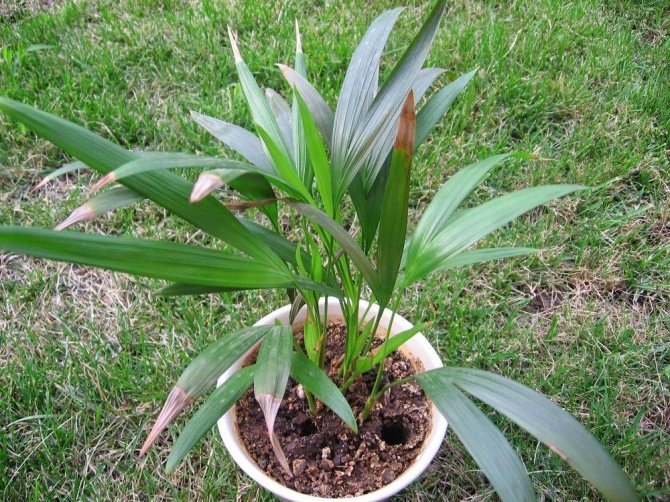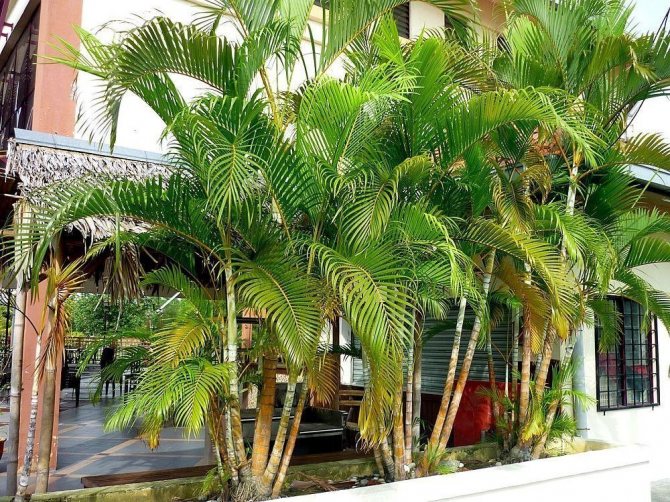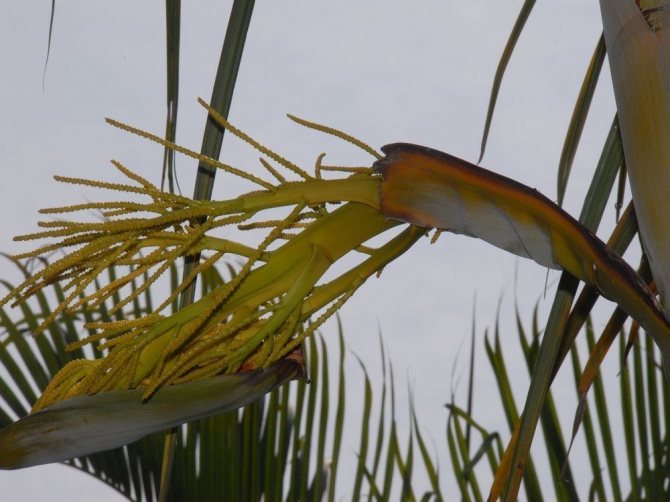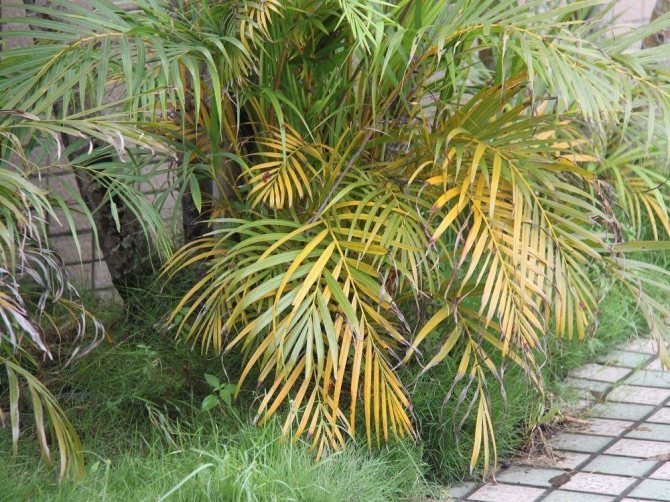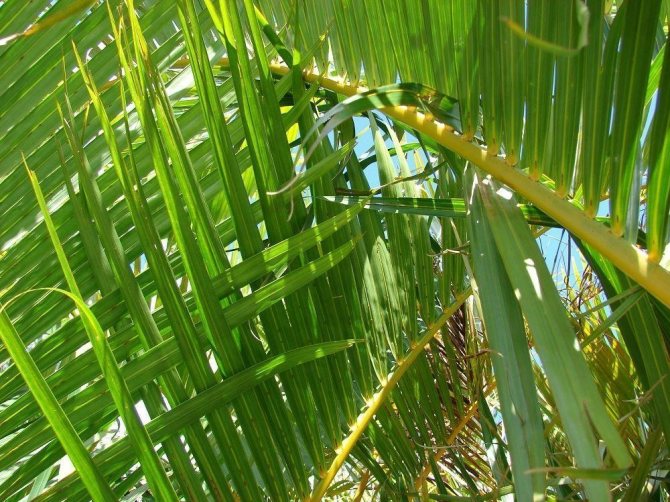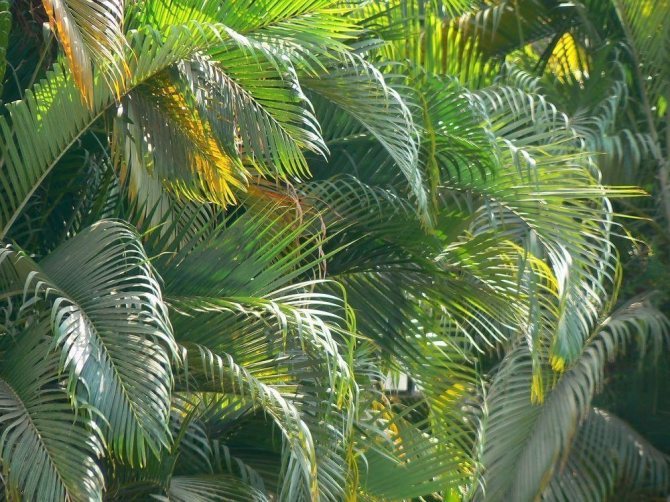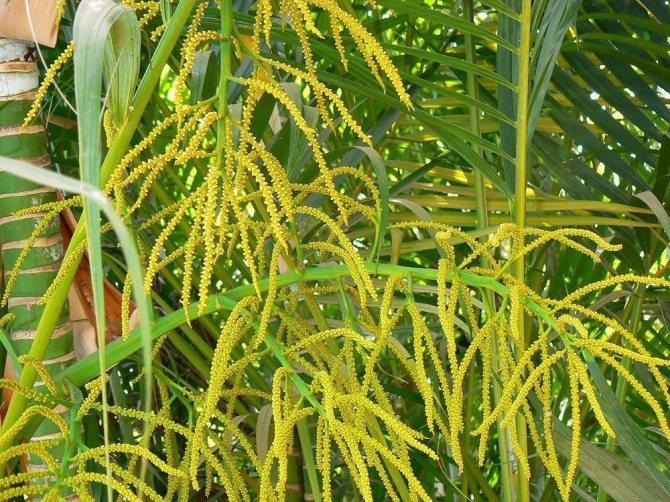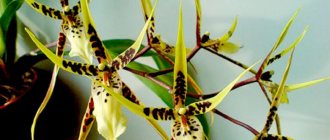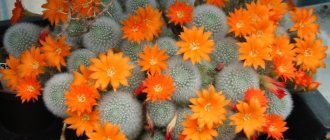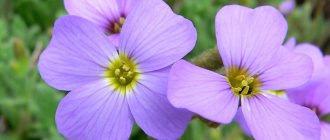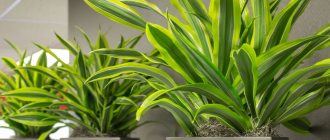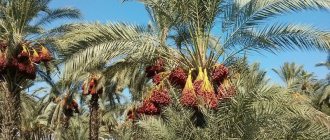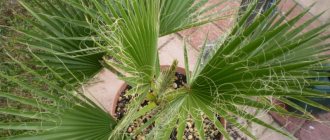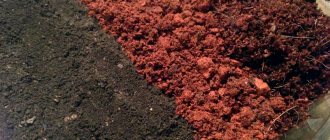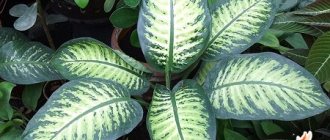Chrysalidocarpus
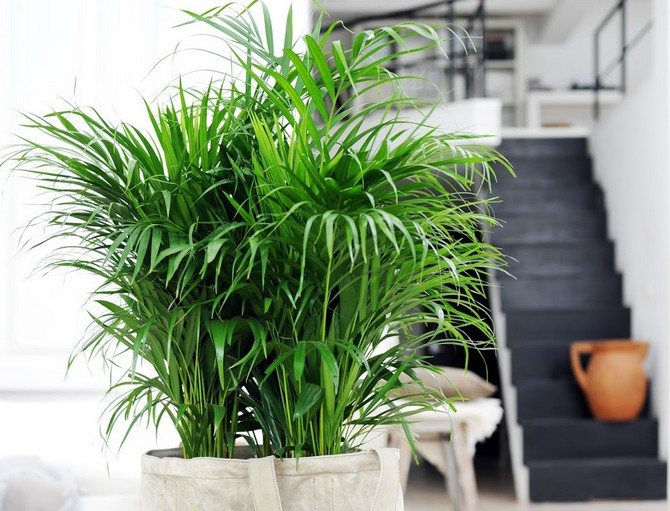
Chrysalidocarpus (Chrysalidocarpus) is an ornamental palm tree, very popular among flower growers due to the exotic beauty of the leaves and undemanding care. This is a tropical heliophyte, that is, a light-loving plant, native to the Comoros and Madagascar. The name translates as "golden fruit", in Greek "chryseus" and karpos ". Belongs to the palm family and the type genus Arekovs.
Sage narcotic
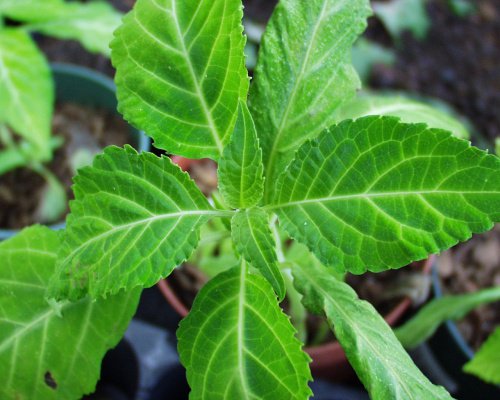

This plant should not be confused with salvia officinalis, the well-known sage of all of us, which is widely used all over the world and does not pose any danger.
It is a green-leaved plant native to Mexico. It contains a substance such as salvinorin. It is capable of causing severe hallucinations and confusion.
In some regions, this plant is used as a natural drug for certain rituals.
Thus, narcotic sage causes serious disorders of consciousness in humans, which ends with the loss of control over their behavior. The negative consequences of this can accompany a person throughout his entire subsequent life.
Chrysalidocarpus care at home
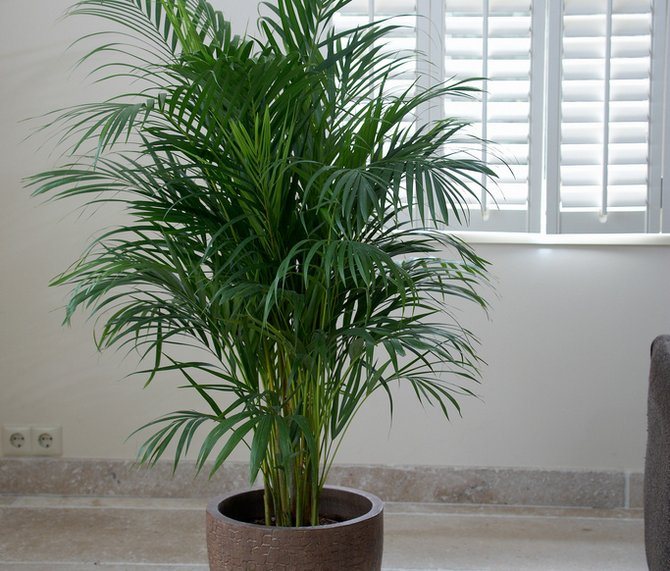

Location and lighting
Accustomed to the tropical sun, the chrysalidocarpus plant tolerates heat and bright light well. Plant pots can be safely placed on the southern and southeastern windows, but in summer it is better to shade them from the midday heat.
Too excessive lighting can harm the leaves, they begin to bend and curl, and from the resulting burns they turn yellow and die off. Young palms are especially sensitive to excessive light, but after the age of six, chrysalidocarpuses are more resistant, and react only with yellowed leaves.
To maintain symmetry, 1-2 times a month, the palm tree needs to be rotated around its axis by 180 degrees.
Temperature
The best is warm air of 22-25 degrees in the summer months, in winter it is slightly lower - about 18-23 degrees, but not less than 16 degrees. The older the plant is, the more calmly it reacts to changes or drops in temperature. However, drafts should be avoided.
Air humidity
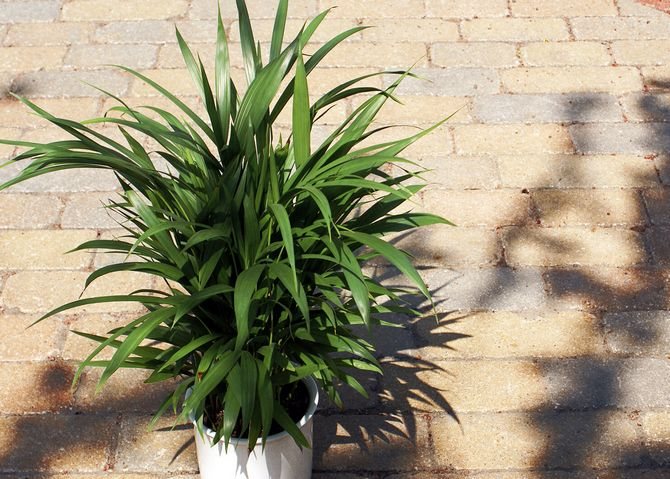

The humidity in the room with the growing chrysalidocarpus should be high. During the summer months, ensure the plant is regularly sprayed with soft, clean water, and wipe the leaves with a damp cloth or sponge. In winter and autumn, you do not need to spray.
For good growth and development of a palm tree, it must be watered abundantly enough, but not allowing excess moisture. It is unacceptable to use hard and chlorinated water, only settled or bottled. In the autumn-winter period, watering is reduced, allowing the substrate to dry out, but not overdrying.
The soil for chrysalidocarpus should be acidic or neutral, well-drained. This is a mixture of clay-sod (2 parts), humus-leaf (2 parts), peat (1 part) soil with the addition of coarse sand (1 part) and charcoal (1 part). Store-bought soil for palm trees will work as well.
Top dressing and fertilizers
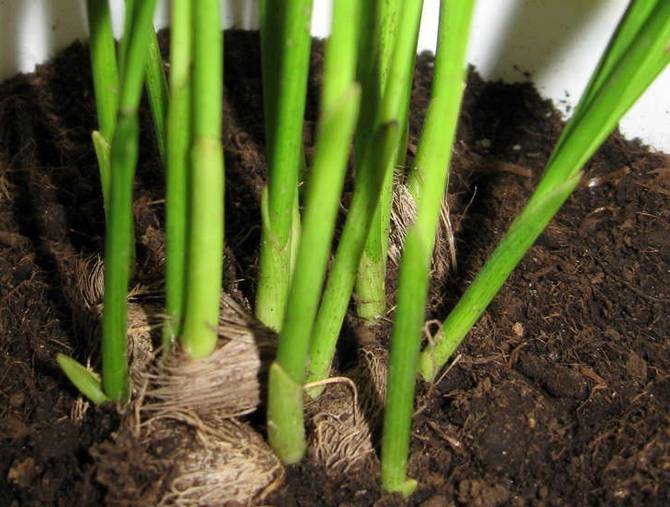

Chrysalidocarpus should be fertilized throughout the year. In spring and summer, 2 times a month with special fertilizers for palm trees or ordinary fertilizers for decorative deciduous plants. In autumn and winter - less often, once a month is enough.Additional foliar feeding with microelements is carried out monthly during the growing season.
For a successful transplant, it is necessary to keep an earthen ball, some of the roots can be cut off with a sharp knife for better placement in a new pot. Drainage is replaced, part of the earth is filled up. The best time to transplant is mid-spring. Young palms are handled annually, older specimens - once every 3-4 years.
Success secrets
In order for the crown to be symmetrical, you need to regularly rotate the container with the plant for versatile lighting.
It is strictly forbidden to be in a draft or in a place open to strong winds in the fresh air.
Overheating is dangerous for Dipsis, therefore, when kept indoors, ventilation is needed during the summer heat. In winter, it is necessary to provide sufficient illumination intensity. You can read about the choice of lamps for such illumination in the article: "The basics of proper lighting of indoor plants."
Young Dipsis is transplanted every year. A mature plant is moved to a new container every two to three years or less. When transplanting, it is easy to injure the roots, therefore, the transplant is replaced by the transfer of an earthen clod with roots into a larger container.
To preserve decorativeness, dry leaves must be removed regularly. It is important not to damage the barrel in this case.
The growth of Dipsis leaves per season should compensate for the amount of foliage removed in one sanitary pruning.
Reproduction of chrysalidocarpus
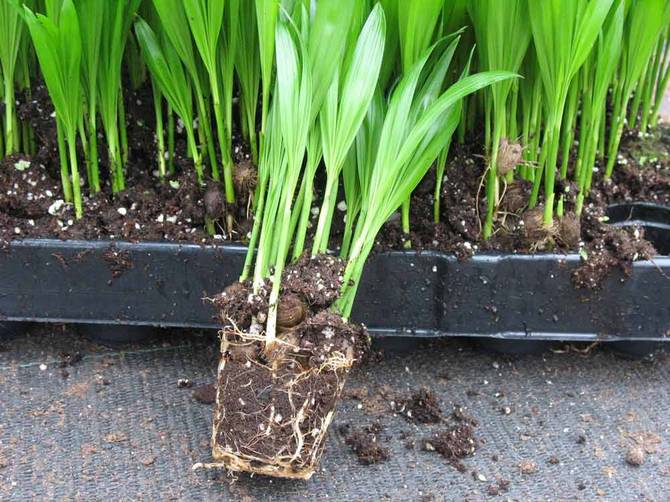

Chrysalidocarpus can reproduce in two ways - by seeds and basal processes.
Seed propagation
In order to propagate chrysalidocarpus using seeds, you must first soak them for 2-4 days. A solution of sulfuric acid or ordinary warm water (about 30 degrees) is used to soak the seeds. The optimum temperature for germination is 25-30 degrees, at a lower germination the seedlings will appear much later. For the growth of seedlings, a well-lit, moist place is required; after the appearance of the first leaf, they are transplanted into small pots. young plants will appear in about 3-4 months.
Propagation by basal processes
Chrysalidocarpus can reproduce vegetatively at any time of the year. With the help of a sharp knife, a shoot is separated at the base of the plant, which already has a small root, and is planted in moist soil. The optimal landing time is spring and summer.
Hydrangea
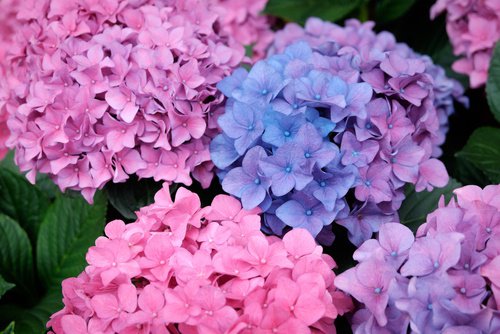

This plant is well known to each of us due to its beautiful flowers. His homeland is Japan. There are more than a hundred varieties of hydrangea in the world that can be grown both in the home and in the garden.
But it must be remembered that the leaves and flowers of this plant contain hydragerin. This compound can cause severe poisoning in humans and animals. The action of this poison is similar to that of cyanide.
It is believed that hydrangea roots can have a number of medicinal properties. However, it is recommended to avoid their use, given the high risk of poisoning.
Diseases and pests
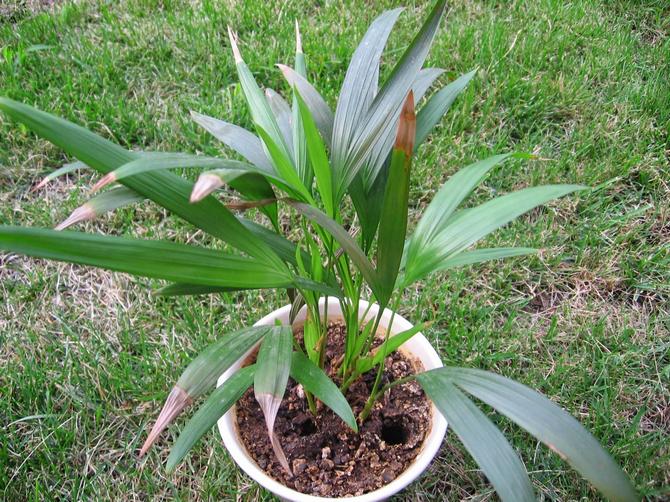

The plant can be affected by fungal infections of the helminthosporium genus - dark spots with a yellow rim appear on the leaves all over the leaf, subsequently forming significant necrotic areas. This leads to the defeat of even new, healthy leaves.
How to deal: the disease manifests itself on those plants that are often sprayed. To eliminate the disease, it is necessary to treat the chrysalidocarpus with a fungicidal solution and stop excessive moisture and watering.
Worms can infect leaves from below, damaging them and causing them to turn yellow. How to fight: rub the leaves with alcohol and treat with an insecticidal preparation.
If the leaves dry up and yellow dots appear on them, these are mites. How to fight: Acaricide is used, and the humidity in the room rises.
Transfer
Palm trees do not like frequent root disturbance, so regular replanting can damage and stop the plant from growing.
Repotting once every couple of years will be sufficient, although if a very young plant is obtained, it may need to be repotted every spring until it reaches maturity.
Mature plants need to be replanted every two to three years. The plant likes a spacious container, and overflowing with roots helps to limit the size of the plant. The main reasons for replanting are replacing aged potting soil and removing fertilizer salt deposits that accumulate in the soil and on the sides of the pot. Use palm soil or a general-purpose mixture supplemented with a handful of clean building sand.
Place the palm tree in the new pot at the same depth as in the old one. Planting too deep can cause serious injury. The roots are fragile, so don't try to spread them out. After filling around the roots with soil, tamp down with your hands to make sure the soil is firm. Eliminate air pockets by flooding the container with water and pressing again. Add additional soil as needed.
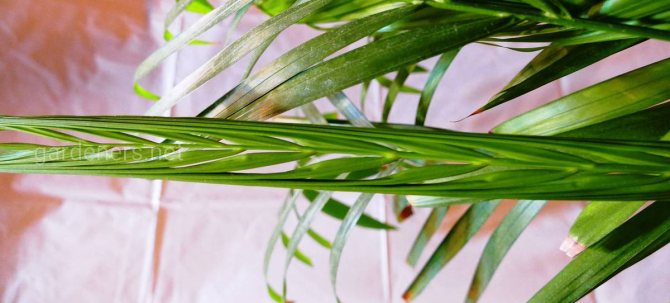

Reproduction... Chrysalidocarpus palms propagate by seeds, by separating shoots and suckers at the base of a mature plant or by dividing the plant.
Diseases and pests
Check regularly for pests by examining branch backs and new shoots. If a palm tree becomes infected, spray it with warm water and soap or insecticidal soap at a 1: 2 concentration. Spraying with a product containing alcohol can damage the leaves. Since the palm tree requires high humidity, it is susceptible to fungal diseases. Pink rot develops in moist soil and causes the branches at the top to brown and sink. Ganoderma, which spreads through the soil, causes the lower branches to drop and turn yellow, and then gradually moves up the plant. None of these diseases can be treated, but they can be prevented if the soil is dry and there is good air circulation around the plant.
Possible problems
- Some parts die off.This is not always a cause for concern, because the stems of chrysalidocarpus often turn brown and die off, especially with age. If there is a lot of salt accumulation in the soil, the palm tree can move the accumulated salt into the branches to protect the rest of the plant from them. These branches subsequently die, trapping excess salt inside. When this happens, simply carefully trim away the dead or dying parts to make the plant look attractive. Salt accumulation can be avoided by rinsing the plant at least once a year with clean water. Let the water flow through the bottom of the container for a few minutes.
- Leaves with brown edges or tips.This is usually a sign of very dry air, so increase the humidity to prevent this.
- Black edges or tips appear on the leaves.This is most likely caused by excessive moisture or burns. In both cases, it is necessary to reduce the amount of fertilizer provided. Once they turn black, they cannot be saved, so you need to cut off the blackened parts, ideally at an angle, so that it does not look so obvious.
- The leaves are covered with brown spots.Excess water can cause brown spots on the leaves. In addition, the temperature may be too low or there may be a lot of fluorine in the water used. Water less often, keep warm, and try to use rainwater or bottled water when watering.
- Yellow leaves or stems.A yellow trunk is normal for chrysalidocarpus. However, this is often a sign that the root ball has been allowed to dry completely. Try to keep the soil moist for most of the year and only allow it to dry briefly in winter.
Growing problems
- The ends of the leaves dry and darken - dry air and substrate; low temperature and mechanical damage.
- Leaves turn yellow - there is too much sun; watering needs to be increased.
- The leaves are covered with brown spots - the soil is waterlogged; sharp temperature drop; watering with hard or tap water.
- Darkened foliage on the entire plant - too abundant watering; decay signal.
- The ends of the leaves are brown - the air is too dry; low air temperature; lack of moisture.
Botanical description
The genus of chrysalidocarpus combines single-stemmed or bushy plants. In their natural environment, they can grow up to 6-10 m in height, but indoor specimens do not exceed 50-200 cm. Long fronds have a dense, erect petiole that does not form lateral processes. Each branch has 40-60 pairs of narrow-lanceolate lobes. The dark green leaf blade has smooth edges and a pointed end. The palm tree develops rather slowly. The annual growth is about 15-30 cm. At the same time, the bush expands annually due to the many basal processes.
Flowering occurs in May-June, but indoor specimens rarely delight with flowers. In the leaf axils, paniculate inflorescences are formed, which consist of small, yellow flowers of both sexes. As a result of self-pollination, fruits ripen - yellow rounded berries. Each berry contains a seed. The seeds are poisonous, their use leads to the development of peptic ulcer and even stomach cancer.
Popular varieties and types
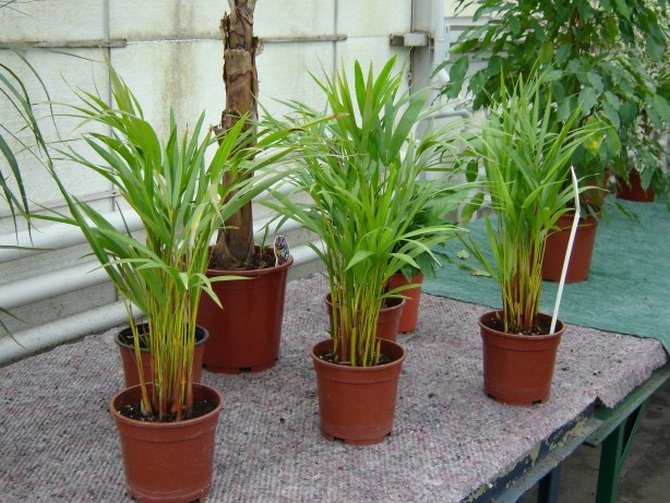

Chrysalidocarpus yellowish (Chrysalidocarpus lutescens)
This type of palm got its name for its yellow-orange stems, which are densely branching at the base. Leaves of almost the same shade, the so-called fronds, can reach almost a meter in width and up to 2 m in length. The furrowed elongated petioles have a scaly dark cover that disappears with the age of the plant.
Read also: Water hyacinth (eichornia): features of growing in a pond or aquarium
Yellowish chrysalidocarpus does not produce yellow fruits characteristic of other species of this genus; in rare cases, dark purple ones appear on it, which practically does not occur under room conditions.
Chrysalidocarpus madagascariensis (Chrysalidocarpus madagascariensis)
A palm tree with one trunk, 20-30 cm in diameter and clearly defined rings. It grows more than 8 m, feathery smooth leaves are arranged in bunches, about 2 cm wide and up to 40 cm long. Branched inflorescence in leaf axils up to 50 cm long. Can be kept in warm rooms.
General information
Chrysalidocarpus lutescens - native to the island of Madagascar and the Comoros. The name Chrysalidocarpus from Greek means “golden fruit”. The second name of the plant is “reed palm”. Loves moisture, as in the ground. and in the air. It is a tropical heliophyte.
Description
With its structure, chrysalidocarpus most of all resembles a bush, since, as a rule, several stems grow from the ground.
Under natural conditions, a palm tree will grow to 7-10 m.However, its indoor species is undersized and does not exceed 2 m, but more often grows up to 1 m.
The growth of a palm tree occurs slowly, in 1 year no more than 30 cm, but in width it increases faster, due to the appearance of new stems.
The plant blooms in late May - early June, but mainly in nature, the plant considers home conditions not entirely suitable for flowering. However, occasionally, chrysalidocarpus blooms with yellow paniculate inflorescences that appear in the leaf sinuses.
After flowering, yellow fruits (berries) of the plant are formed. The berry contains the seeds of the plant.
Important! Chrysalidocarpus seeds are extremely poisonous and should not be eaten.
The palm tree perfectly regulates the humidity in the room, increasing it. Creates the feeling of a rainforest in an apartment or office. One plant is enough to make a space green.It is believed that the plant takes negative energy from the surrounding space and gives positive energy.
Chrysalidocarpus species
The most common type of plant at home is chrysalidocarpus yellowish... The plant got its name for its yellowish stems and leaves, which grow up to 2 m.Chrysalidocarpus is 0.8 - 0.9 m wide.
Chrysalidocarpus three-stalked grows up to 3 m at home. The leaves grow straight from the ground, and when flowering, the plant smells like lemon.
Chrysalidocarpus Madagascar - in nature it grows up to 9 m, has one trunk with a whitish bark, expanding to the bottom. The inflorescences of the plant are large, up to 60 cm. The leaves are dark green in color.
Betel palm (catechu) - a large species of chrysalidocarpus, growing up to 20 m, with a single trunk and many long thin leaves. The view is used in the south for landscaping gardens and parks. It rarely blooms only if it considers the conditions worthy.
Chrysalidocarpus - description, what kind of care and possible difficulties?


Chrysalidocarpus, the Arecaceae family, is a fairly common palm in culture, native to the Comoros and Madagascar. The genus got its name from the yellowish color of the fruit. Translated from the ancient Greek chryseus - "golden", karpos "fruit". Sometimes the palms of this group are called the outdated name of Areca.
Chrysalidocarpus - single-stemmed and bushy multi-stemmed palms up to 9 m tall. Shoots are erect, unbranched, smooth or pubescent, sometimes swollen, in rings, give lateral offspring and generally form a group. The leaves are pinnate, with 40-60 pairs of lanceolate leaves, dissected at the apex, located at the apex of the stems on thin petioles. Some species develop basal leaves around the stem and merge into the crown. Plants are mono- and dioecious.
Chrysalidocarpus prefers bright light and is able to tolerate direct sunlight. Suitable for placement near southern windows. Shading is required only in the summer - from the midday sun.
In the summer, chrysalidocarpus prefers an air temperature of 22-25 ° C. In the rest of the year, a palm tree needs a warm content - 18-23 ° C, not lower than 16 ° C. All year round, it is necessary to provide the palm tree with fresh air, avoiding drafts.
Chrysalidocarpus loves high humidity, so frequent spraying is recommended in warm seasons. In summer, the plant should be regularly sprayed with soft, settled water at room temperature. Spraying is not carried out in autumn and winter. In chrysalidocarpus, the leaves should be washed at least twice a month.
Chrysalidocarpus in the spring-summer period is watered abundantly, with soft, settled water, as the upper layer of the substrate dries up. From autumn, watering is reduced to moderate, without bringing the earthen lump to complete drying. In autumn and winter, care should be taken that there is no overflow, this is very dangerous for the plant. Watering in the autumn-winter period should be 2-3 days after the top layer of the substrate dries out.
Chrysalidocarpus needs feeding all year round. In spring and summer, a palm tree is fed 2 times a month with special fertilizers for palm trees or mineral fertilizers for decorative deciduous plants. In the autumn-winter period, they are fed once a month.
Chrysalidocarpus prefers a land mixture - 2 parts of light clay-sod land, 2 parts of humus-leaf, 1 part of peat, 1 part of rotted manure, 1 part of sand and a little charcoal.
You can use the prepared soil for palm trees.
Chrysalidocarpus has a hard time transferring, therefore it is replaced by transshipment with replacement of drainage and filling of earth. Young, actively growing specimens should be reloaded annually, adults - after 3-4 years, instead of reloading tub palms, the top layer of the substrate is changed annually. There is always good drainage at the bottom of the pot.
Chrysalidocarpus is propagated by seeds and suckers.
The seeds are soaked in 30 ° C water for 2-4 days. Then they are sown in light peat soil. The seeds germinate at a temperature of 20-25 degrees in a lighted, humid place. Young plants appear in 3-4 months. When the first leaf is formed, they are transplanted into 10-12 cm pots.
From the lower adventitious buds of chrysalidocarpus, offshoots are easily formed, at the base of which roots develop. These shoots are easily detached from the mother plant and take root in light soil, which is best done in spring or summer.
Growing
Dipsis was massively domesticated in the 80s. XX century The results of NASA studies carried out at that time showed that the plant effectively moisturizes and purifies the air by filtering toluene and xylene. Such useful Dipsis "settled" in winter gardens, greenhouses, halls of public premises, offices, houses and apartments.
In warm seaside regions, Chrysalidocarpus adorns outdoor landscape compositions. It looks impressive in single and group landings.
To grow Dipsis indoors, you need an outdoor flowerpot, tub or pot of classic shapes, with a narrow bottom and a wide top.
The substrate for indoor palm consists of humus, leafy earth and sand in a ratio of 2: 3: 1. It is possible to plant or transplant Dipsis into a ready-made substrate for Palm trees. For soil drainage required by Dipsis, river pebbles, terracotta or gravel are added to the mixture.
Dipsis is picky about the conditions of maintenance and care. The plant needs a sufficient amount of bright light. Therefore, Dipsis is located in a bright place of southeast or southwest orientation. Light partial shade is acceptable.
It is not recommended to keep Dipsis in direct sunlight. This leads to yellowing of the leaves and loss of decorative effect.
The optimum temperature for keeping is 22-25 ° С.
Dipsis is hygrophilous. Water the plant regularly and abundantly in the warm season, as soon as the topsoil dries up. For irrigation, only settled soft water is used. The palm is gently watered from above.
In the colder months, watering becomes more moderate, but due to the lack of a pronounced dormant period, it does not stop.
For a healthy appearance of the terrestrial part of the plant, constant humidification of the air nearby is required. Dipsis leaves should be regularly sprayed and washed with warm water.
Dipsis, like other Palms, needs additional feeding. They are applied once a month from spring to autumn. In addition to complex fertilizers for Palm trees, Dipsis is suitable for feeding for Dracaena and Yucca. The general principles of their use are described in the publication: "The use of fertilizers for indoor plants."
You will find useful tips on keeping Dipsis and other Arekovs in the article: "Growing Indoor Palms".
Chrysalidocarpus, features of care and possible difficulties
Chrysalidocarpus - the most popular representative of indoor palms, from the Greek chryseus - golden and karpos - fruit.
Originally from Madagascar and Oceania. In natural conditions, it can grow up to 9 meters.
There are two types of indoor palms according to the type of leaf arrangement - pinnate and fan. It is the fan-shaped branches that resemble a human hand (from Latin “palm” is translated “palm”). One of these fan palms is the palm chrysalidocarpus yellowish from the Areca clan. Indoors, it grows in the form of a bush with a height of 1.5-2 meters.
The representative of the feathery room palm is Chrysalidocarpus Madagascar - leaves are located on one trunk, collected to the place of fusion with the trunk in bunches.
Chrysalidocarpus is unpretentious, in great demand.


The genus Areca includes 50 species.
Chrysalidocarpus yellowish
Chrysalidocarpus Madagascar
Chrysolidocarpus Madagascar takes its name from Ch. Madagascariensis, synonym - diptis madagascar... Its single trunk slightly widened downwards has pronounced rings and a smooth surface. The leaves are arranged in bunches, have a glossy surface. A more general name is applied to it - areca palm.
Read also: Alycha Kuban comet: characteristics, pros and cons
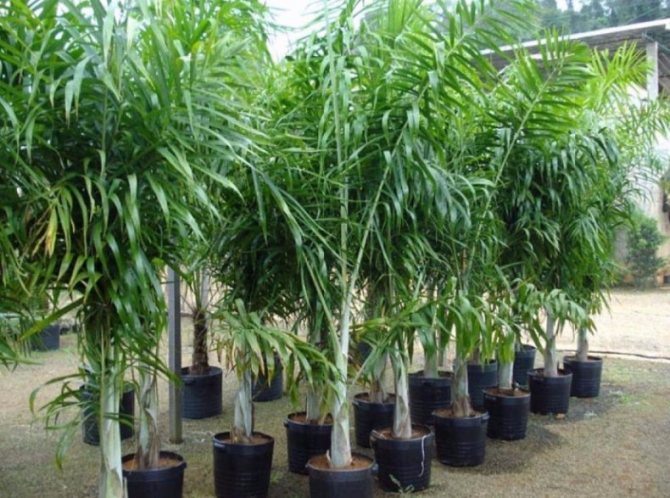

Caring for areca palm trees at home involves following simple basic rules.
Household palms have a high need for light, so the place for it should be well lit. But the condition of fencing from drafts and direct sunlight from 11 to 15 o'clock in the summer remains mandatory.
Forming plants are more vulnerable. Adults can change the place at the request of the grower - it will feel comfortable in partial shade and on the north side.
Temperature
For the comfort of a plant in winter in an apartment, you need to maintain a temperature of 18-23 degrees, 21-25 degrees in summer - in such conditions, the palm tree will be comfortable. It can tolerate short temperature drops (up to + 15 ° C).
Air humidity
Like all tropical plants, chrysalidocarpus loves humid air. Spraying helps to maintain air humidity in the house, which should be carried out once every 2-3 days. A shower can be used for mature plants. After each spraying or shower, you need to remove the remaining water on the leaves.
So that the leaves do not dry out and do not lose their shine, the palm tree should be placed away from heating appliances. Fresh air also has a beneficial effect on this plant.


Proper and regular watering is an important condition for home care for chrysalidocarpus.
Chrysalidocarpus needs to be watered after it has been dried for a couple of days. It is advisable not to fall on the stems. After 2-2.5 hours, you need to remove water from the pan - the plant does not like stagnant water in the pot. If the water does not go away, you need to clean the drain.
The frequency of watering also depends on the season - more often you need to water it in spring and summer. It is useful to alternate watering with spraying.
Chrysalidocarpus is fertilized with mineral dressings once or twice a month. From spring to early autumn. Less commonly fed in winter. In addition to the ready-made store-bought mixture of fertilizer for palms, a universal mineral additive is also suitable, the dosage of which must be used 10 times less than that indicated on the package.
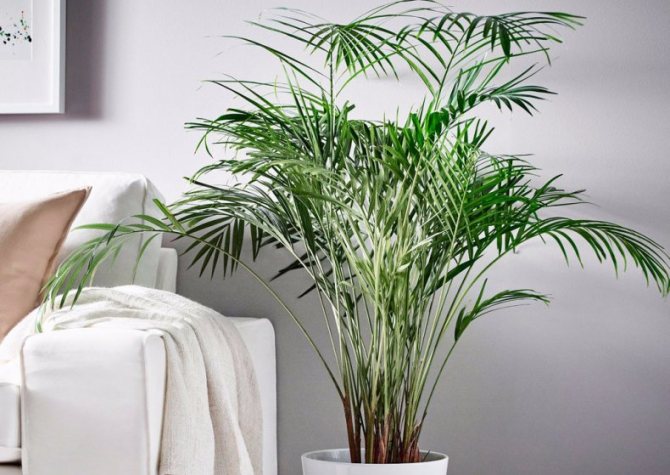

For chrysalidocarpus, a soil mixture of 2 parts of clay-sod land, 2 parts of leaf humus, 1 part of overripe manure, 1 part of peat, 1 part of sand is good. You can add some charcoal to the soil. Soil for palm trees is also suitable.
Transplants are required once every 2-3 years. Before transplanting, you need to prepare the substrate, a tall and deep pot of the appropriate size, so as not to damage the long roots and drainage. First, a drainage layer is placed on the bottom of the pot. Then fill the pot with soil mixture.
For large plants, instead of replanting, the upper depleted layer of the earth is changed.
Watering
These palms come from the tropics, so they are used to a regular tropical shower, in natural conditions their roots are in constantly moist soil. With this in mind, the ideal watering requirement would be to keep the soil moist for most of the time.
All year round, with the exception of winter, this palm is thirsty and needs to be watered frequently and often, especially during the height of summer. If the place of permanent residence is very warm, then you can water it twice a week.
Watering in spring and summer
This is the time of the year when Chrysalidocarpus is actively growing.
Despite the desire for moisture, too much water will kill the plant. Therefore, it is best to make sure the soil surface is dry before watering again.
Use rainwater if you have access to it to avoid fluoride build-up.
Watering in autumn and winter
With the onset of autumn, start reducing your watering because Chrysalidocarpus's water needs are starting to decrease.
Only when the soil is a couple of centimeters dry do you wet the soil again to moisten the roots.
Watering 2 or 3 times a month should be sufficient.
But that depends on where Chrysalidocarpus is: if it's in full sun, its needs will certainly be higher.
Top dressing. Feed the palm tree starting in spring. This gives the plant a large amount of the nutrients it needs throughout the season. Liquid houseplant fertilizer can be used for this purpose. Make sure the fertilizer is safe for foliar feeding and dilute according to label directions. Do not feed chrysalidocarpus palm plants in autumn and winter.
Reproduction
Chrysalidocarpus is propagated by sprouts and seeds. Sprouts use those that have formed at the base of the trunks. Planting a palm tree with seeds is even easier than with sprouts. Better to sow them in a greenhouse. If the soil is warm, the conditions are met, then the seeds germinate on the 30-40th day. The seeds are stored at a temperature of 18-22 degrees.
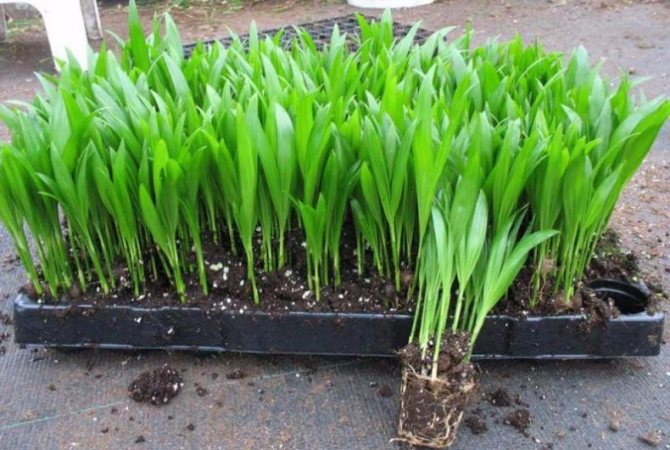

Before planting, they are soaked in +30 ° C water for 2-4 days. After soaking, the seeds are sown in light peat soil and placed in a well-lit place with humid air, in which the temperature is kept within 20-25 degrees. When the first leaf is formed in 3-4 months, the seedlings are transplanted into 10-12 cm pots.
Vegetative way
In any season of the year, you can propagate a palm tree vegetatively. For this, an offshoot, which already has a small root, is cut off with a sharp knife at the base of the plant and planted in moist soil. It is best to do this from spring to autumn.
Shine
The palm tree will grow even in an area that rarely receives sunlight during the day, but is best for a lot of light, even a small amount of direct sunlight. Excessive direct exposure to the sun, which can dry out the plant, must be avoided.
It is best to place the chrysalidocarpus near a west-facing window, where it will have enough light.
If you live in a fairly dark apartment, don't buy the Chrysalidocarpus because it does a poor job of dealing with the lack of light.
Place the chrysalidocarpus in the right place.In our climatic conditions, the palm tree adapts well to life in our apartments and houses. She feels best when the ambient temperature is kept between 18-22 C.
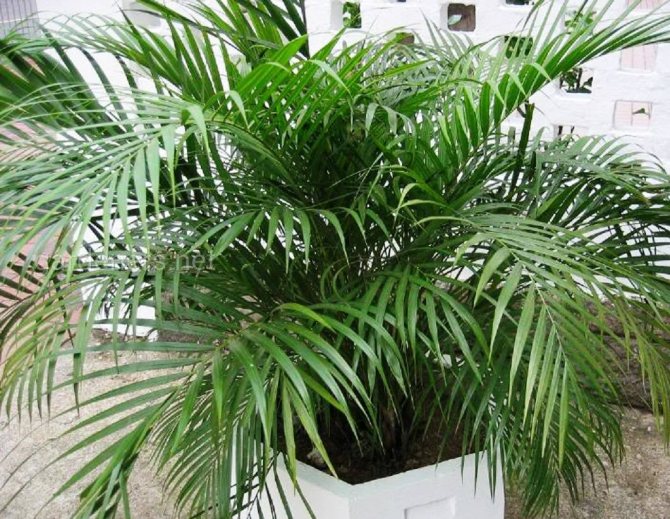

Possible difficulties
Excessive soil moisture can lead to mold and rot. In this case, you also need to revise the care of the plant by drying the soil. Excessive feeding, oversaturation of the soil with fluorine or superphosphate can lead to browning of the tips of the leaves and to their death.
As a result of the plant getting sunburn, the leaves may turn yellow or turn brown, and well-defined spots may appear on the leaves. In this case, you need to urgently transfer it to partial shade.
Waterlogging of the soil, or a sharp drop in temperature, or watering with hard water can cause leaf spot to appear.
With sufficient light and air humidity, good care, chrysalidocarpus will be a luxurious plant. He is better suited for greenhouses, hallways with a natural source of light, winter gardens, closed terraces, large halls, which he will effectively decorate with himself.
Plant transplant when buying or planting
This plant does not like transplanting, therefore it must be carried out exclusively in rare cases, when the rhizome of the Areca Chryza has already grown very much and needs free space. Since the roots of this flower are very thin, when transplanting, it is necessary to remove the entire earthen lump from the pot.
Important! You need to choose a deep pot for planting, since the roots of this plant go deeper and do not grow in width.
A thick layer of expanded clay must be poured onto the bottom of the pot. It will absorb excess moisture and gradually release it into the soil as it dries.
After transplanting, the plant is left in the room and provided with diffused bright light.
Popular Chrysalidocarpus - home care for a butterfly palm


Chrysalidocarpus - This is a fairly common and easy-to-care palm tree, perfectly grown indoors. The name of the palm tree comes from the ancient Greek roots chryseus - golden (yellow) and karpos - fruit.
The palm tree grows in nature in Madagascar and Oceania. At home it grows up to two meters, in the open field it can grow up to 9 meters.
Read also: What you need to know for trout farming
In the next article, we will look at the main points: home care, photos, problems with growing, and more.
Philodendron
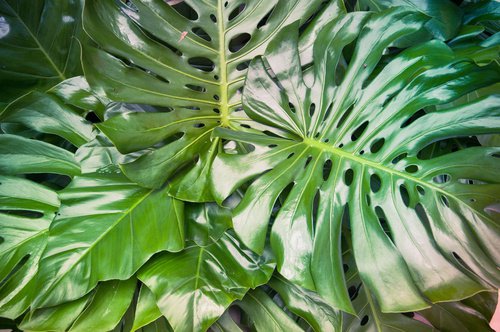

This beautiful plant with carved leaves is often found in our homes. In nature, it is common in tropical forests, where the philodendron grows twisting around the trunks of other trees. This species has many varieties.
This plant is only dangerous if eaten accidentally.
The calcium oxalate it contains can cause burning mouth, throat irritation and stomach pain. In more severe cases, it can cause seizures, loss of consciousness and even death.
In some cases, a person managed to survive, but irreparable harm was caused to his health - chronic liver or kidney failure developed.
Popular types
There are 8 plant species classified in the genus Chrysalidocarpus. The two most popular types of chrysalidocarpusthat can be found in stores:
- Chrysalidocarpus yellowish(Ch. Lutescens Wendl). Synonym - Yellowing Diptis. There is the name Chrysalidocarpus lutescens. From one base, 2-5 yellowish trunks grow, covered with small black dots. Petiole up to 60 cm, yellow, furrowed.


This video talks about the yellowish chrysalidocarpus palm.
Madagascar (Ch. Madagascariensis). Synonym - Diptis Madagascar. Smooth, slightly widened at the bottom, with pronounced rings. The leaves are pinnate, with a glossy surface, the leaves are arranged in a bunch.
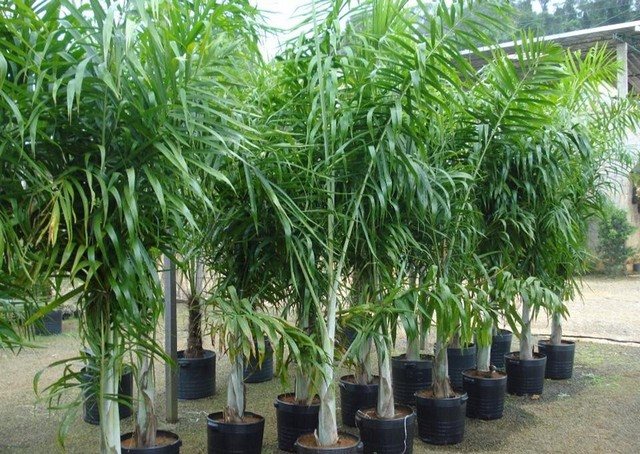

The main species of chrysalidocarpus
In nature, there are about 20 species of chrysalidocarpus. The most famous among them are Yellowish and Madagascar.
Chrysalidocarpus yellowish (Chrysalidocarpus lutescens)
Scindapsus - home care and breeding methods
This species is also called yellowish dipsis. It belongs to the reed palms and is a dense dense bush with shoots coming from the very roots of the mother tree. Its height reaches 2 m.
Chrysalidocarpus lutescens has beautiful yellowish-variegated leaves that form an arc as they grow. Young petioles and leaf stalks are covered with scales, which come off over time, but small black dots remain in their place.
Important! If proper conditions are provided for a palm tree, then the width of its leaves can reach 90 cm, and even 1 meter long.
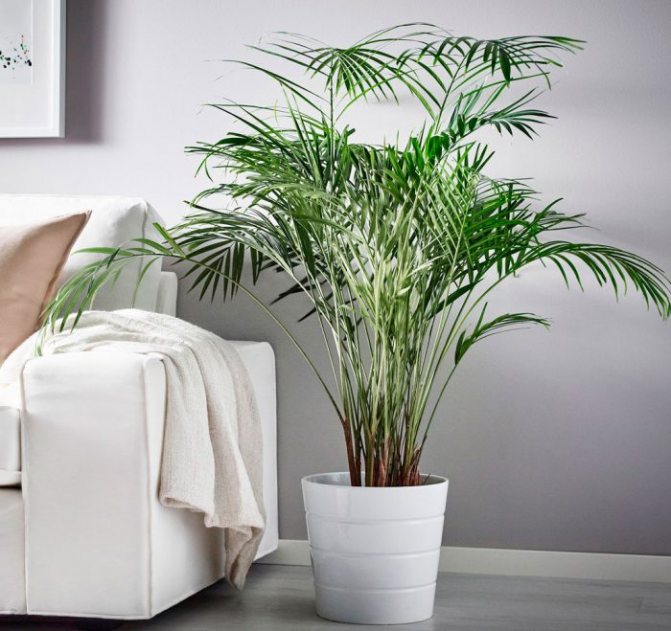

Yellowish appearance
Chrysalidocarpus Madagascar (Chrysalidocarpusmadagascariensis)
The Madagascar species is a tall plant. In natural conditions, its height reaches 9 m, but in a domestic environment it is much lower. The feathery leaves of this plant are collected in bunches. Their length becomes 45 cm. A single flower stem has a ring-like structure.
Home care
Consider the main points about Areca: home care, diseases and pests.
Features of care after purchase
Do not try to replant the palm tree right away. into a beautiful new pot. Place the plant where you have chosen for it. Do not expose the young plant to bright sunlight - young leaves may turn yellow. Drizzle with warm water. Watch for a couple of days.
If the plant does not show signs of lack of light or moisture, the plant can be transplanted. Choose a pot more than the one in which you bought the chrysalidocarpus.If the roots are crawling out of the pot, this means that the root system does not have enough space for growth.
Choose a massive pot, broad-based... He has a powerful developed root system, the roots need a lot of space.
Chrysalidocarpus - light-loving plant, likes a long day, up to 12 hours. In winter, this tropical plant needs additional lighting.
Although palm trees tolerate direct sunlight well, but a young plant must be protected from the hot sun in summer... If, under the summer sun, the leaves turn yellow (turn brown) and fall off, urgently rearrange it in diffused light (for example, darken the window with a curtain if the palm tree is near the window).
Temperature
Likes moderate temperatures, in winter 18-23 degrees, in summer 21-25 degrees. Tolerates a short drop in temperature up to +15 degrees. Do not place the palm tree near radiators and other heating devices - the leaves will dry out and lose their shine.
If possible, take the plant out into the fresh air in summer.
Air humidity
Palm trees love high humidity, in the summer like regular spraying. Do not spray in autumn and winter. From time to time wash the palm leaves with a damp cloth, if plant growth allows - under the shower. You can and should sometimes immerse the pot in water so that the entire earthy clod is saturated with water.


Need to water often and abundantly in summer and spring... As soon as the top layer of the earth dries up, you can safely water it.
Autumn and winter - a dormant period, you need to water less often.
You can alternate watering with spraying. You need to monitor the drainage of the pot. Chrysalidocarpus really does not like stagnation of water in a pot.
If you notice that the water is standing, drain it and loosen the soil, transplant the palm tree into soil with good drainage.
Indoor conditions rarely blooms... When flowering, it releases a brush with small yellowish inflorescences.
Fertilizers (top dressing)
Chrysalidocarpus is fertilized with mineral dressings from spring to early autumn, once or twice a month. In winter they feed less often. You can use an all-purpose mineral fertilizer for indoor plants, or choose a fertilizer for palms.
Do not transplant unless absolutely necessary. Palm trees love when their root system is tightly intertwined, so experienced palm growers advise replanting a palm tree only when the root system breaks the pot.
Instead of transplant, use transshipment... This means - you need to get an earthen clod of a palm tree, shake out the old soil and drainage from the pot, fill in fresh soil and drainage composition and plant a palm tree in the same pot.
These videos tell you about the transplant rules.
First steps after purchase
In addition to temporary quarantine and preventive treatment against diseases and pests, the purchased young Dipsis needs to be intensively illuminated. The correct light regime will soon neutralize the stress of transportation.
The stay of Dipsis in the transport ground is comfortable for the plant. Unless absolutely necessary, do not rush to a transplant.


ON THE PICTURE: A young copy of Dipsis.
Diseases and pests
Chrysalidocarpus is susceptible to infection spider mite... The appearance of a cobweb on the leaves is the cause of dry air. Spray the palm tree more often, treat with an insecticide, collect the visible cobweb with a cotton swab.
Leaves dry
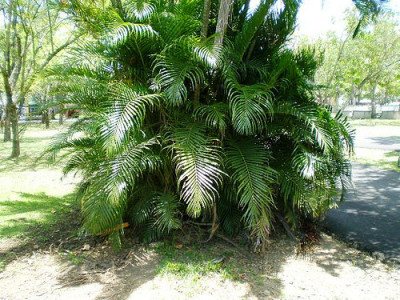

Dry leaves, tips, edges of leaves Are the most common palm problems. The most common problem is lack of moisture.
Spray often, move it away from the battery, place a container of water next to it.
If the problem persists, then it is worth reconsidering the feeding.
Dying off, browning of the tips of the leaves can be a signal of an excess of fluorine, superphosphate, an excess of feeding.
If it turns yellow
The appearance of yellow (brown) well-defined spots on the leaf in summer Is a signal that the plant has received a sunburn. Move the chrysalidocarpus from direct sun to partial shade.
Belladonna


This plant is widely known as a homeopathic remedy. In order for it to be beneficial to humans, it is used in microscopic doses.
Why is it not recommended to keep this plant at home? The fact is that the alkaloids contained in it are highly toxic.
In ancient times, this plant with purple flowers and black berries with an unpleasant odor was used as a poison. There are many legends and fairy tales on this topic.
Plant keeping rules
One of the main requirements that must be met in order to grow a beautiful and healthy palm is high-quality lighting. For this, the southern windows of the dwelling are ideal. But bright sunlight, especially in summer, will not be to your liking for chrysalidocarpus. From noon, it is better to protect the flower from direct exposure to rays. As the plants grow older, you can rearrange the pot to a less illuminated area. An adult palm tree easily tolerates partial shade. In which pot should chrysalidocarpus grow? Home care involves the complete elimination of drafts and overheating of the plant. These factors are detrimental to the foliage and root system of the palm tree.
The optimum temperature for good development is 20-25 degrees. But even if the thermometer drops to 18, the palm tree will not die. However, growth in such conditions will be slower. Watering is done as needed and in no case should be excessive. The root system does not tolerate waterlogging. It is necessary to ensure that no moisture remains in the pan of the pot with the plant. To eliminate impurities, water from the irrigation tap must be filtered or defended for several days.
What else does yellowish chrysalidocarpus need? Home care should definitely include moisturizing the foliage, especially in the summer. Using a spray bottle, you can spray the green part of the palm tree every 3-4 days. For mature plants, you can arrange a real shower, but with care so as not to break the stems with the jet. Excess moisture on the leaves must be removed.
Signs and superstitions about chrysalidocarpus
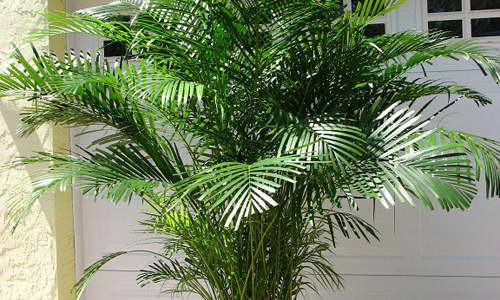

Chrysalidocarpus areca home care photo
Sometimes people ask the question: can the chrysalidocarpus palm be kept at home? Based on the studies carried out by scientists, yellowish chrysalidocarpus, along with aloe vera and chlorophytum, is able to cleanse the air from harmful substances, including formaldehyde and even heavy metals. Increases air humidity, enriches the air with ozone and oxygen.
For those who are fond of feng shui, a butterfly palm tree will maintain a favorable atmosphere in the house. She is dual, so she can give positive energy and take negative energy, especially from sharp corners.
This beauty can develop a sense of natural thickets even in the smallest room. And in general, it is pleasant to take care of her, because the green color has a positive effect on the psyche, soothes.
It is important: you should be careful with the fruits and seeds of this charming woman. They are poisonous! In no case should you use them for food, self-medicate. You can cause significant harm to the body!
> Dipsis (Chrysalidocarpus)
Types of titanopsis home with photos and names


In indoor floriculture, titanopsis calcareous is most often found. (Titanopsis calcarea)... Its leaves are painted in different colors from gray-green to ocher-brown, and the flowers are lemon yellow.
Other popular types:


Fuller's titanopsis (T. Fulleri) with dark yellow flowers;
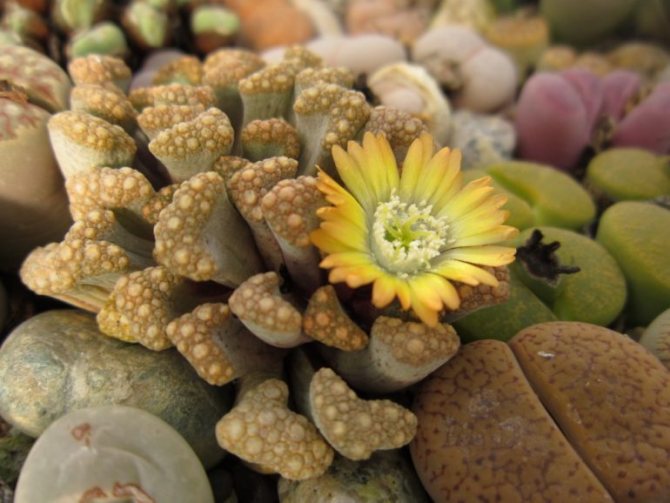

titanopsis Hugo-Schlechteri (T.hugo-schlechteri) with ocher orange flowers
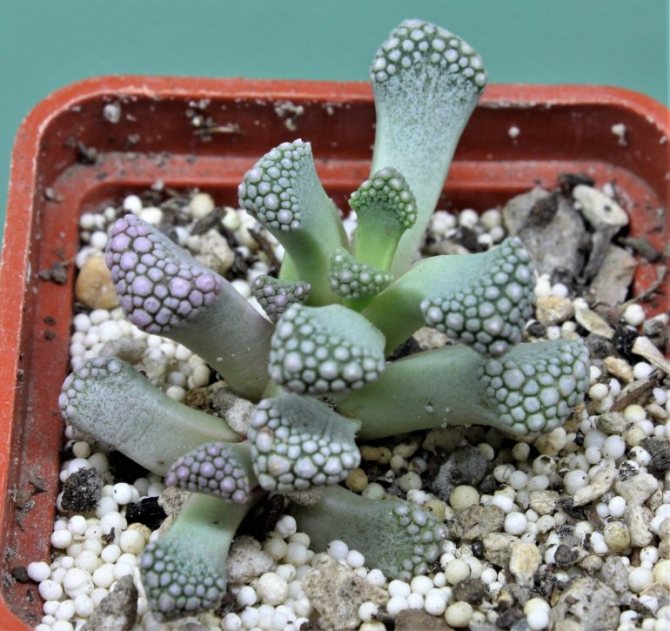

titanopsis luderite (T.luediritzii) with double flowers, the extreme petals of which are bright yellow, and the core ones are snow-white.
Common types of dipsis
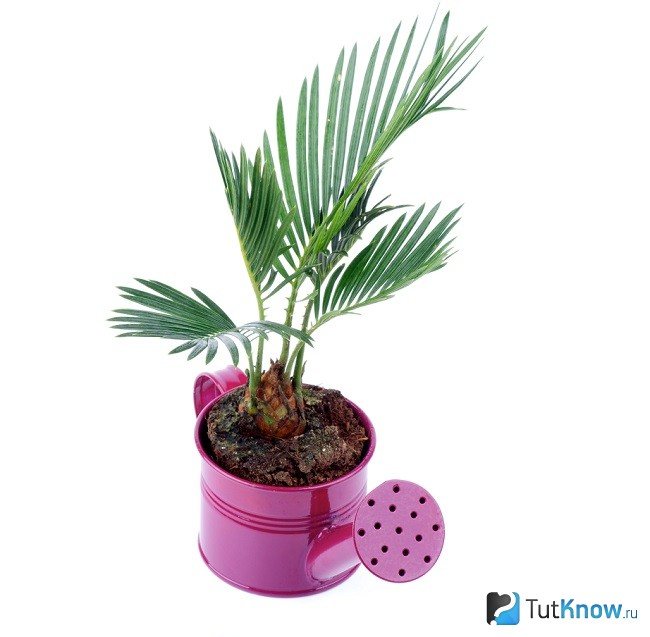

Dypsis lutescens or yellowish dipsis (synonym for Chrysalidocarpus lutescens) is widespread among florists around the world.Sometimes it is called yellowish chrysalidocarpus. Among sellers, the name of the areca palm will be more common. This is due to the use of a common name for the entire Arecaceae family.
Neodipsis grows on the east coast of the large island of Madagascar, located near the southern part of the African continent. Today, representatives of this beautiful species are under the threat of complete extinction, and no more than a hundred specimens remain in the places of their historical growth. Together, this palm is one of the most common species that have become actively grown in tropical climates and home gardening around the planet. This medium-sized and extremely graceful palm tree gained particular popularity on the islands of Haiti, Cuba, Antilles, Jamaica, El Salvador, etc.
Neodipsis is a multi-stemmed palm tree, where refined daughter stems grow on the base of the maternal one. This is how a group of 5–20 stems is formed, each of which, under appropriate conditions, can stretch up to 10 m in height, reaching 10–11 cm in diameter. Over time, the trunk of a palm tree begins to look more and more like a bamboo, becoming covered with specific scars that leave fallen leaves behind.
At the top of the dipsis, there are wide arched leaves that adjoin the stem and are directed upward. The petioles of small leaves, from which a long palm leaf is formed, has a beautiful yellowish tint. It was he who served as the reason for the formation of the specific name of this plant. However, science knows certain varieties in which the petioles have acquired a green or bluish tint, and their surface is covered with small black scales.
If the necessary conditions are met, then the period of flowering of the palm tree falls on the end of the spring or the beginning of the summer period. It is extremely difficult to achieve flowering in the atmosphere of a dwelling, therefore, you should not rely on getting yellowish fruits that palm trees from the genus Dipsis bring.
Chrysalidocarpus dries: why and what to do?
Chrysalidocarpus dry leaves what to do
Butterfly palm is a chic decorative flowerpot that does not require special care in good light and humidity. But difficulties cannot be avoided.
Chrysalidocarpus leaves tips dry
Dried leaves, tips, edges are the most common problems. The first reason is a lack of moisture (dry air and substrate). As well as low temperature and mechanical damage. With such problems, you need to increase the number of sprays of the plant, remove it from the battery, install a container of water nearby.
Chrysalidocarpus leaves turn yellow and die off
The tips of the leaves can not only turn yellow, but also turn brown, and then die off. The reason may be an overabundance of feeding, which contains fluorine, superphosphates.
The leaves become covered with brown spots if a full bouquet of unfavorable conditions is collected: a sharp temperature drop, water for irrigation is too hard or taken from the tap. If the leaves have completely darkened, this is a signal of decay. Watering needs to be stopped urgently.
Yellow-brown spots will tell you about the plant getting sunburn. The palm tree urgently needs to be transferred to partial shade. The second sign of excess lighting is the wrapping of the leaf, the appearance of straw spots on it.
Chrysalidocarpus species
Botanists count up to 20 species of chrysalidocarpus. Here is some of them:
Chrysalidocarpus is yellowish. The plant, strongly branched from the base, lets out lateral, rooting shoots. Young stems with petioles are yellow-green in color. They have a smooth, speckled surface. Each leaf grows up to 2 m in length. The frond's width is 80-90 cm. Up to 60 pairs of leaf plates are located on the arcuate petiole. Axillary inflorescence is a branched raceme with small yellow flowers.
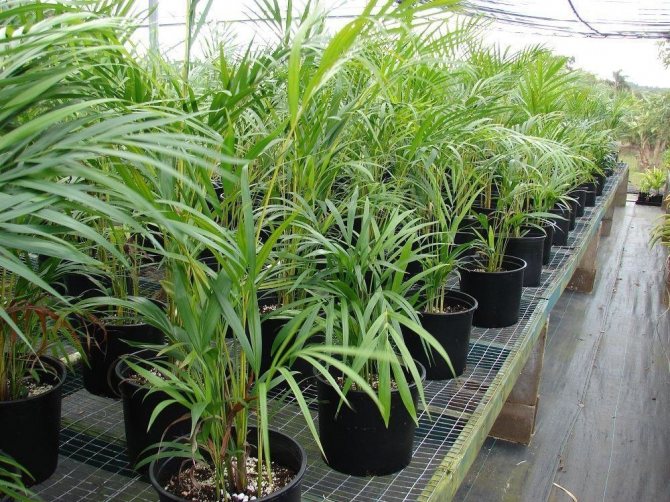

Chrysalidocarpus yellowish
Chrysalidocarpus is three-stalked. The plant is a bunch of erect leaves growing from the ground. At home, it is capable of reaching 3 m in height. Glossy leaf plates are strongly narrowed and elongated. During the flowering period, a rather dense inflorescence with a pleasant lemon aroma blooms.
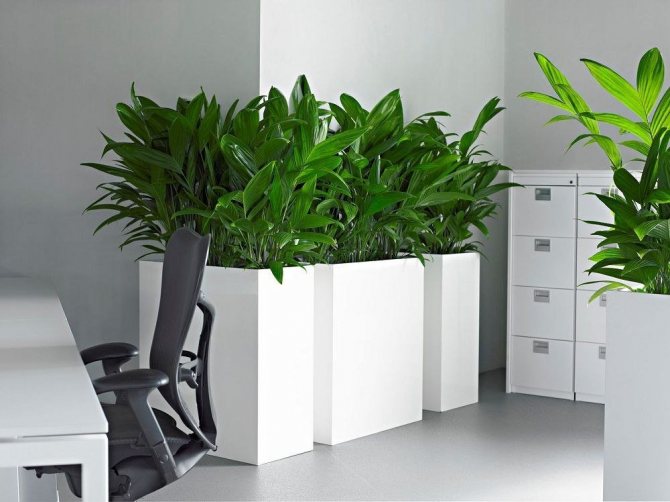

Chrysalidocarpus three-stalked
Chrysalidocarpus Madagascar. The palm tree has a classic tree-like shape with a single trunk. The trunk is slightly widened at the base and covered with smooth whitish bark. The height of the tree in nature reaches 9 m. The dense feathery foliage is colored dark green. The length of the racemose inflorescence is 50-60 cm.


Chrysalidocarpus Madagascar
Chrysalidocarpus catechu (betelian palm). A popular variety with a single massive trunk and long, straight leaves. In nature, the trunk is 20 m long and 50 cm wide. Sprawling feathery leaves form a symmetrical, dense crown of dark green color. The variety is often planted in the south in gardens to decorate the area. Flowering and fruiting are very rare.
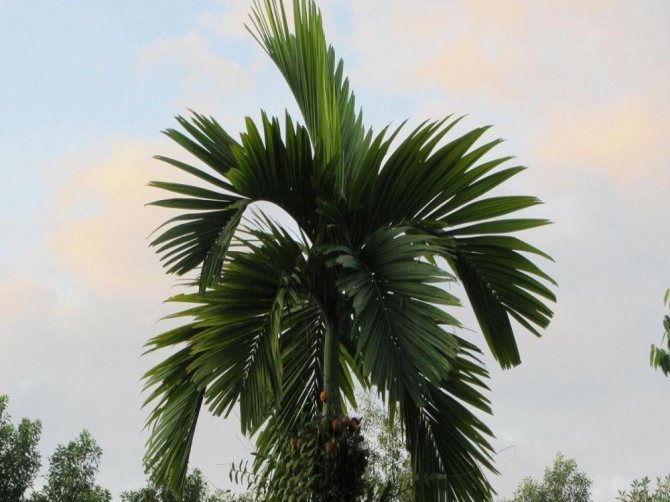

Chrysalidocarpus catechu
The main pests of neodypsis


Most of the hassle when growing a palm tree is delivered by ticks, worms and thrips.
- Mites
different species usually attack the plant at the beginning of spring. It is almost impossible to detect them with the naked eye, but the result of their vital activity quickly becomes noticeable. On the leaves of neodypsis, small dotted spots of a yellow, brown or brown hue are formed. Ticks actively move to neighboring plants, therefore, in case of a disease, it is necessary to treat and apply preventive methods to all flowerpots in the house. To combat ticks, insecticide solutions are used. Leaves and stems of plants are sprayed for 3-4 days, then repeat after a week. After that, using a magnifying glass, you need to carefully examine the plant and, if mites are found, repeat the spraying procedure. - Schervets
settles in the axils of dipsis leaves, and it is easy to notice it by its characteristic white bloom. To combat it, the lesion is wiped with a sponge, which is pre-moistened in an alcohol solution. If this gentle method does not help, then you will need to treat the leaves with insecticides. - Settlement signs thrips
- the appearance of a silvery sheen and brown spots from the lower part of the leaf. The insect is afraid of moisture, so high humidity prevents its appearance. If thrips nevertheless settled, then to combat it, the leaves are wiped with an alcohol solution and a composition of soap foam with ash.
For more useful information on transplanting chrysalidocarpus, see this video:
Mr. Dachnik advises: possible difficulties in caring for chrysalidocarpus and their solution
If the plant grows poorly, gets sick, it needs additional feeding, a certain watering regime, and proper lighting.
| Problem | Signs | Elimination methods |
| Lack of nitrogen | The leaves are light green at first, then yellow, the plant stops growing. | Use nitrate (ammonium, sodium), ammophos, urea. |
| Potassium deficiency | Yellow, orange spots on old leaves, edge necrosis appears, the leaf dries up. | Feed with potassium sulfate, wood ash. |
| Lack of magnesium | Light, wide stripes around the edges. | Top dressing with magnesium sulfate, potassium magnesium. |
| Manganese deficiency | New leaves are weak, with necrotic stripes, small in size. | Use manganese sulfate. |
| Zinc deficiency | Necrotic spots, leaves are weak, small. | Use zinc sulfate or zinc fertilizers. |
| Dry, cold air, insufficient watering | Brown spots on the tips of the leaves. | Raise temperature, humidity, water more abundantly. |
| Excess sun or little moisture | The leaf plate turns yellow. | Shade when too hot, water more often. |
| Brown leaf spot | Watering with hard water, waterlogging, low temperature. | Adjust watering, temperature according to the season, defend water. |
| The lower leaves darken and die off | Abundant watering. The leaves were torn off with their hands. | Cut the plates with sharp scissors. |
| Brown tips of the plate | Cold, dry air, lack of moisture. | Raise the temperature, moisten, water more often. |
Install drainage so that water flows into the pan immediately after watering.
To know when it's time to water - pierce the ground with a sushi stick. When it is slightly damp, you can water it, the soil sticks - it's not time yet.
Genus name.
Taxonomists could not decide for a long time to what genus the plant should be assigned. Previously it was called Areca, then Chrysalidocarpus, and now this palm tree has been attributed to the genus Dipsis (lat.Dypsis). Moreover, each of the previous names managed to gain a foothold. In such cases, they all remain synonymous. After all, it is clear that we are talking about the same plant. In addition, very often manufacturers do not bother with names, but simply indicate the family - Areca (i.e. Areca or, in Russian, Palm).
Chrysalidocarpus substrate
The following substrates are used for chrysalidocarpus:
For the young
Sod (2 parts), leaf, or peat soil (1 part), humus (1 part), sand (1/2 part). With age, it is allowed to increase the percentage of humus in the mixture.
For adult plants
Sod (2 parts), compost (1 part), humus (1 part), peat or leaf soil (1 part) and sand.
Palm trees can hardly tolerate transplanting, so it is replaced by transshipment with replacement of drainage and additional earth filling. At the bottom, the containers provide good drainage.
Propagation by seeds, spring-summer, and separation of offspring.
From the lower adventitious buds of the plant, shoots (offshoots) are easily formed, at the base of which roots develop. These shoots can be detached from the mother plant, which is advisable in spring and summer.
Reproduction of yellowish dipsis
This species can be propagated by seeds that germinate at temperatures above 18 ° C. It is advisable to plant them in the spring in a substrate consisting of equal shares of washed river sand, peat and crushed sphagnum moss. Germination is recommended to be carried out in a greenhouse or under a transparent film in a warm place. Cold snap adversely affects their germination.
Seedlings appear in 4-5 weeks. They grow slowly, so it is preferable to propagate the plant in a vegetative way.
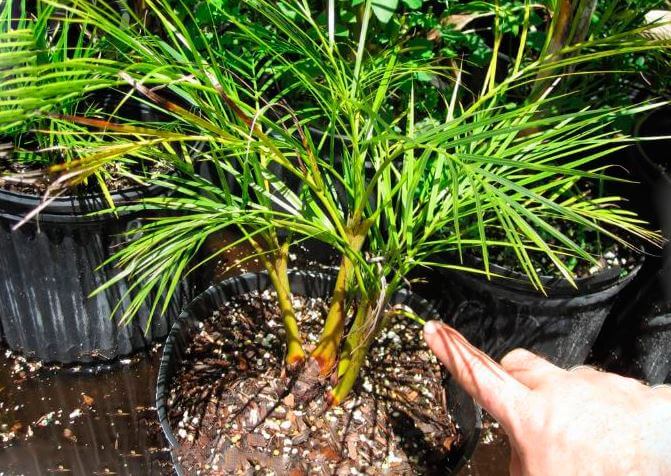

The offshoots are separated from the mother tree before the growing season begins in early spring. Their length should be about 30 cm, the presence of their own roots is required. The shoots are planted in small pots. A mixture of compost soil with fine sand is used as a soil. The pots are placed in a greenhouse or covered with a transparent plastic or glass hood with small holes for ventilation.
Rooting is carried out in a bright and warm place without direct sunlight for 4-6 weeks. After that, the protective cap is removed and the seedlings are watered. The soil must dry out a little between waterings. After the appearance of new leaves, the plant takes root and must be looked after as an adult palm tree. After a year, they can be transplanted into a new pot. In the future, with good growth, chrysalidocarps are transplanted every 2-3 years, paying special attention to the safety of the roots during transshipment.
Spathiphyllum
It is no coincidence that spathiphyllum is commonly called female happiness. Being in the house, this plant helps to solve many women's personal problems:
- In case of family troubles, spathiphyllum helps reconciliation and the establishment of good relations between spouses.
- A flower presented to a lonely girl attracts grooms to her.
- The mistress of the spathiphyllum becomes attractive. She has a sparkle in her eyes, her mood improves.
- A plant located at the head of the bedroom will bring harmony in love to a couple, strengthen feelings.
- If the spathiphyllum is healthy and actively blooming, then there is peace and harmony in the house.The wilting of the leaves indicates the presence of hidden problems.
- If spouses are planning a child, spathiphyllum promotes conception, a pregnant woman will provide an easy and quick birth, it is not for nothing that a convex flower petal resembles a pregnant belly in shape.
Dipsis - care and cultivation
Growing at a temperature of about 20-24 ° C, like all palms, Dipsis does not tolerate heat in a closed room. He needs a lot of fresh air, regularly ventilate the room, put a pot with a palm tree on the balcony for the summer. In winter, a cooler content is required at 16-18 ° C, at least 12 ° C.
Lighting: Dipsis prefers a bright place, shading from the sun's rays in the afternoon, but the sun's rays in the morning or after 4 pm are very beneficial for him. You should not place this palm tree in a shaded place, more than 50 cm from the window, you probably already need to illuminate it on cloudy days and in the autumn-winter period.
Watering: should be uniform, without overdrying or waterlogging. Plentiful in spring and summer, but after the soil dries up in the upper third of the pot. In winter, moderate, wait with watering after drying for a few more days.
Top dressing: carried out from March to September after 2 weeks, with a special fertilizer for palms or any liquid fertilizer for decorative deciduous plants.
Air humidity: the palm tree is very fond of spraying, and small plants can be taken to the shower, once a month, to wash off the dust and carry out a hot shower (45 degrees) to prevent ticks.
Transplant: Dipsis (chrysalidocarpus) is transplanted annually or every two years. Soil - 2 parts of light turf, 2 parts of humus-leaf, 1 part of sand and a little charcoal. It's a good idea to add fine (1-3 mm) expanded clay or vermiculite to the soil, about 2 handfuls per bucket of earth.
Reproduction: by seeds, no problem. Seeds sprout in 30-40 days, it is advisable to use a room greenhouse and soil heating for germinating seeds. Young seedlings are kept at a temperature of 18-22 ° C, periodically airing.
For more information on cultivating and growing palm trees, see Palms
Description of neodypsis


In the historical places of their habitat, representatives of the genus Dipsis are multi-barreled or single-barreled, growing up to 10–12 m, and sometimes even more. In indoor floriculture, palms of this genus are not so large and grow to a height of up to 3 meters, pleasing the eye with beautiful openwork leaves.
Individual types of dipsis are quite diverse and among the predominant number of single-barreled ones there are the so-called reed palms. They are exotic bushes with multiple leaves growing directly from the ground. Also, the genus neodypsis contains original species that look like full-fledged palm trees with a beautiful crown and textured trunk.
Indoor representatives of the genus dipsis always look very impressive and at the same time are absolutely unpretentious to the conditions. On elongated thin stems there are wide feathery leaves, consisting of paired lanceolate leaves 1–2 cm wide. In common species, the number of such pairs reaches 5–6 dozen, and the leaves themselves reach 1 m in width and up to 3 meters in length.
When grown in residential premises, neodypsis almost never blooms, only in greenhouses or conservatories. Flowers are formed in the axil of the leaf and represent a paniculate inflorescence, consisting of separate groups. Each of them has 1 female and 2 male flowers. The latter self-pollinate the female flower and soon yellowish fruits appear on the palm.
Features of palms of the genus Dipsis


The yellowish chrysalidocarpus has been awarded by the Royal Horticultural Society for its aesthetic appearance. However, the palm tree became widespread after special studies organized by NASA scientists. The aim of the trials was to find out which plants are likely to provide the most benefits when grown at home.As a result, it was found that dipypsis removes hazardous gases of toluene and xylene from the air, while enriching it with oxygen and increasing humidity.
Of all the types of palm trees that have become popular for indoor cultivation, neodypsis is the most difficult to maintain. It is not recommended to use it when landscaping commercial premises, since periodically very aggressive external factors arise in them, the appearance of which is not allowed and can greatly harm. It is best to grow varieties of areca palms in conservatories and greenhouses, as well as in the rooms of residential buildings, providing suitable conditions.
To create the right atmosphere, you need to provide a sufficient level of illumination, a lot of fresh and warm air. The presence of drafts is not allowed, especially if the plant has not yet matured. Adult palms are already less whimsical and can withstand insufficiently comfortable conditions, while young plants often die due to lack of light or moisture.
Description
The genus Dipsis belongs to the Palmaceae family, or Arecaceae. It includes 162 varieties. Under natural conditions, these Palms grow in the humid forests of the Comoros and Madagascar. Dipsis are found in the tropical forests of Asia, Puerto Rico, El Salvador, the Antilles and Andaman Islands, Cuba, Haiti, Jamaica.
Dipsis received the synonymous name Chrysalidocarpus for its fruits. Chrysalides translated from Greek means "golden pupa of a butterfly", karpus - "fruit".
Palm trees of the genus are single-stemmed or bushy. In nature, they grow up to 10 m in height, in culture they are rarely higher than 3-5 m.


ON THE PHOTO: Landings of Dipsis in exotic countries fascinate tourists.
The stem is smooth, green in color. At a young age, it is thin as a reed. As it matures, the stem thickens and resembles bamboo.
Leaves grow up to 2 m long and 80–90 cm wide. This is the most decorative part of Dipsis, thanks to its interesting fan-cut shape, leathery surface and unusual color. The light green shade of the leaf blade is aesthetically emphasized by the yellowish tone of the leaf sheath and petioles. Small black scales are located on the petioles. Some cultivars have bluish or bright green leaf petioles.
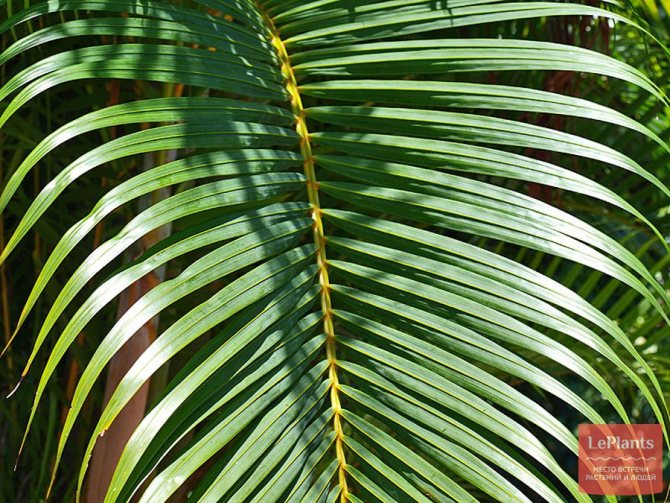

IN THE PHOTO: Chrysalidocarpus leaf.
Inflorescences are paniculate, axillary, densely branched. The length of each inflorescence reaches 50-60 cm. In nature, Dipsis blooms in the spring and summer months, rarely blooms in indoor conditions.
Fruits are small, round, golden yellow. The seeds are large, of various shades of brown.
Dipsis seeds are used not only for plant propagation. Processed with the help of special technologies, they turn into beautiful beads, interior prayer beads and other aesthetic accessories.
Popular varieties
At home, Dypsis lutescens (Dypsis lutescens) is more often grown. This variety is known as Areca Palm, Yellow Palm, Butterfly Palm. It features a beautiful arched crown and original branched inflorescences with yellow flowers. The species is honored with an award from the Royal Horticultural Society.
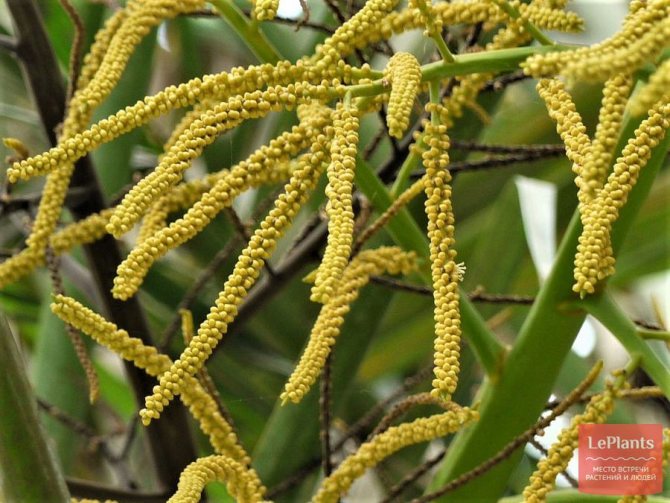

ON THE PHOTO: Yellowish Dipsis bloom.
Dypsis madagascariensis (Dypsis madagascariensis) is found in greenhouses and winter gardens. The highly decorative Palm is notable for its glossy feathery leaves and golden inflorescences.
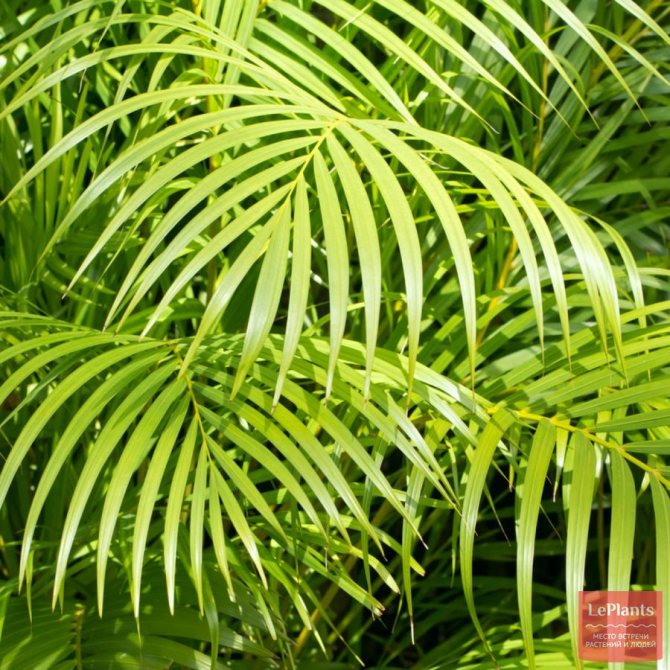

ON THE PHOTO: The bright exotic foliage of Dipsis Madagascar simply cannot go unnoticed.
Growing titanopsis from seeds
Seeds are sown in loose, slightly moistened soil, slightly deepening, but not sprinkling them on top. Under glass or film at a temperature of about + 30 ° C and good illumination, the seeds germinate in a few days.
Seedlings are left to grow in the same container without picking for six months, so as not to injure them.When young titanopsis have a third pair of true leaves, the plants can be planted in individual pots. They will bloom after 2-3 years.
Plant use
Chrysalidocarpus fits perfectly into the interior, regardless of the style of its design. Bright greenery and exquisite leaves bring you closer to nature. The plant is known to be able to quickly absorb large amounts of water, which it later evaporates. Thus, chrysalidocarpus not only pleases with a beautiful appearance, but also improves the air quality in the house. It removes vapors of benzene, formaldehyde and carbon monoxide.
In the homeland of the plant, its fruits are used in folk medicine. Alkaloids and tannins are found in large quantities. With the help of the pulp of the berries, they fight worms and diarrhea. However, do not forget about the toxicity of seeds. In order not to be mistaken in the dosage, it is better not to use this drug inside.
Spread
Dipsis yellowish originally from Madagascar. In the wild, it grows in the provinces of Antsiranana, Fianarantsoa, Tuamasina and in the Mananara Nord National Park, located in the northeast of the island.
The palm tree is found mainly in marshy areas along the sand dunes on the coast of the Indian Ocean, much less often in the highlands up to 300 m above sea level. It was introduced and acclimatized well in the Canary and Andaman Islands, Cuba, Haiti, Costa Rica, Venezuela, Jamaica, the Dominican Republic, Brazil and southern Florida.


Chrysalidocarpus is grown as a houseplant in many countries of the world. It adapts well to new conditions, can grow both in the sun and in partial shade, withstand short-term frosts down to -2 ° C.
Under natural conditions, yellowish diphysis grows up to 6-12 m, and in closed rooms no more than 1.5-2 m. The palm tree has several trunks, the thickness of which is 5-8 cm.Depending on the lighting, they can turn green, yellow or orange tones. Crown width on average reaches 4 m, and height 3.3 m. It has a gray-green or silvery shade.
The length of pinnate leaves is 1.8-2.4 m, and their segments are 60-70 cm. The peduncle is drooping and branched. The flowers are yellow. Egg-shaped fruits 2.5 cm long are colored yellow-orange, purple or almost black.
Common Dipsis Diseases
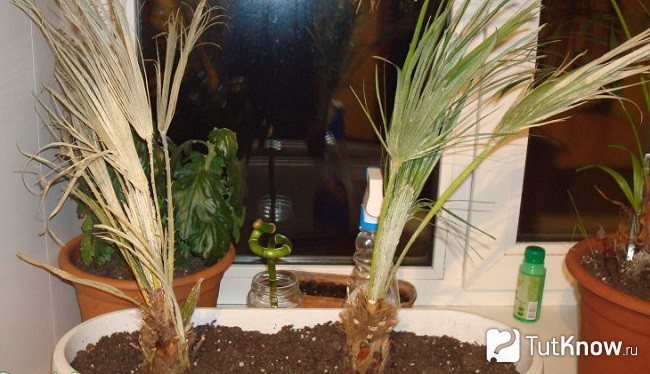

If you do not follow the rules for caring for the plant, then the leaves of neodypsis can become stained and dry. Depending on the lack of certain attention, the following external signs appear:
- if brown spots are seen on the leaves, then it is usually a consequence of an excess of moisture, low temperature or extremely high water hardness;
- when the leaves at the base of the palm turn brown, in most cases this is a consequence of the natural aging process;
- if only the tips of the leaves dry up and turn brown, then this indicates a weak level of air humidity or a lack of moisture in the soil;
- the rounded shape of the dark spots that appear on the leaves most likely indicates a sunburn, so the plant should be placed in the shade, avoiding the harmful effects of ultraviolet radiation.
Due to improper care, the following dangerous diseases can occur.
- Due to waterlogging, the appearance of root rot
... Symptoms are yellowing of the leaves, which darken over time and dipsis dies. If, against the background of the onset of the disease, the temperature drops or there is a lack of useful minerals in the soil, then the disease will rapidly progress and then it will become impossible to save the plant. It is possible to fight root rot only in the early stages, when neodypsis is transplanted into another pot, while cutting off the affected areas of the roots. Before planting in a new soil, the roots are immersed in a solution with a fungicide for 20-25 minutes.In places where the roots are cut off, the wounds are sprinkled with ash or cinnamon, after which the dipypsis is planted in disinfected soil. Then the plant is watered twice with a fungicide solution. - Often young leaves suffer penicillosis
, which usually affects the apex of the neodypsis. The first sign of the disease is the appearance of small necrotic spots. Over time, they grow and the presence of a whitish coating can be detected in the infected areas. It is left by fungal spores, under the influence of which the leaves of the palm tree lose their natural shape. Fungal infection always originates and develops in the soil, and only then gets over directly to the plant itself. - In addition to penicillosis, dipsis can also be attacked by others. fungal infections
... An indicator of their appearance is the leaves of the plant, on which lonely spots of various shapes and shades appear. If the palm is over-watered, it serves as a catalyst to accelerate the development of the fungus, which quickly spreads to the stems and leaves. To combat it, use a fungicide solution, which is sprayed 2-3 times a day on all affected areas.
How to transplant chrysalidocarpus
This palm tree has a rather powerful root system, so a young plant should be transplanted annually. Chrysalidocarpus tolerates this procedure rather painfully. Therefore, it is best to transplant the plant by transferring the plant, when the drainage is replaced in the pot and the earth is filled up. Adult specimens should be transplanted no more than once every 3 years. The optimal period is March-April.
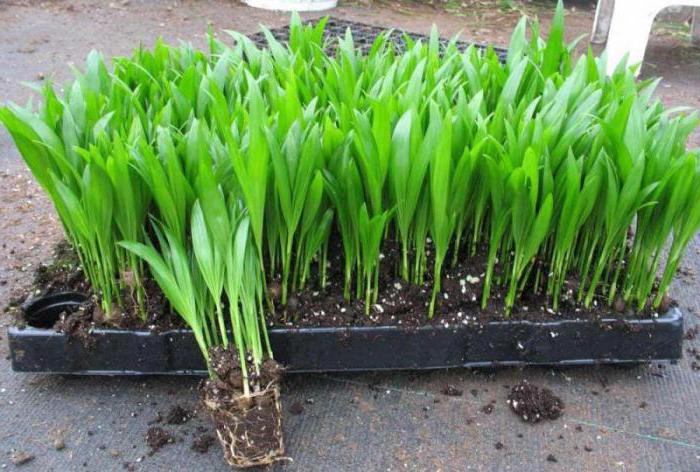

It is better to purchase a deep pot in which the chrysalidocarpus will feel comfortable. Care implies high requirements for the soil mixture in which the palm will be grown. Its drainage qualities are very important. Stagnation of moisture is detrimental to the plant, therefore, a mixture of pumice, pine bark, pebbles, peat, humus, charcoal will be optimal in composition. A ready-made, purchased substrate for growing palms from a flower shop is also suitable.

